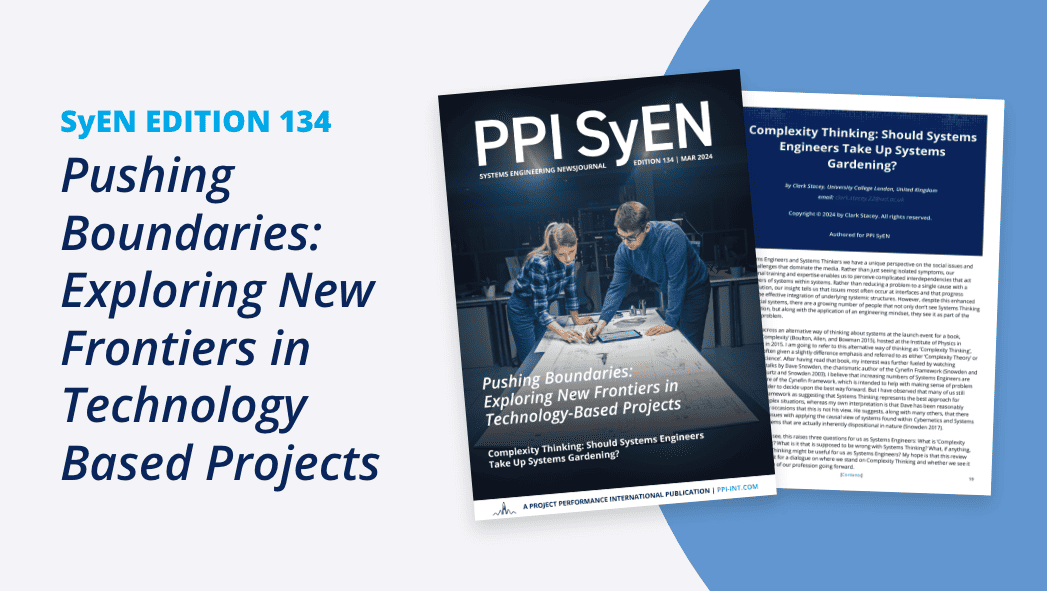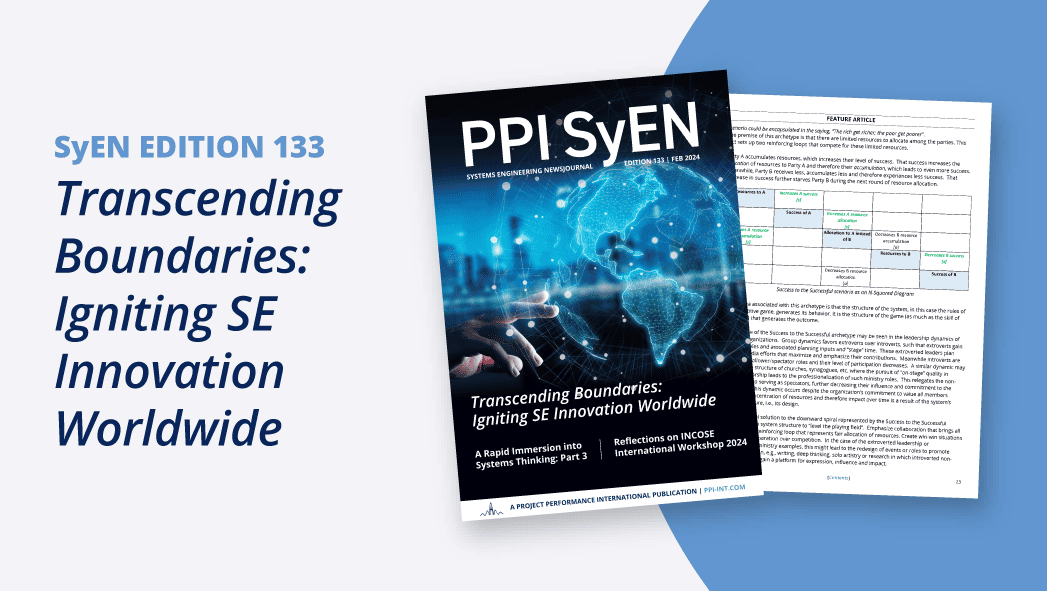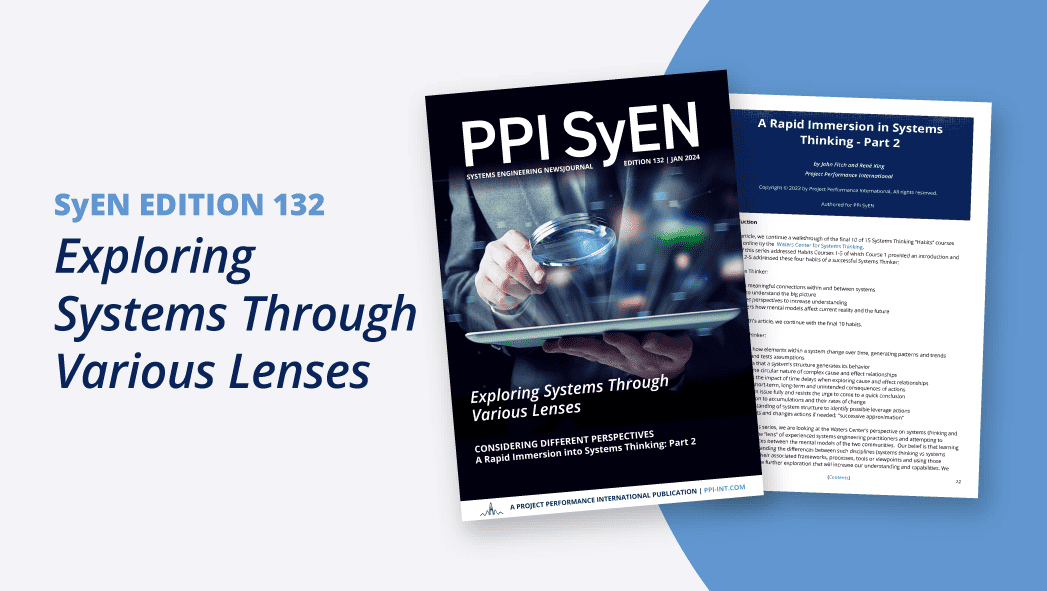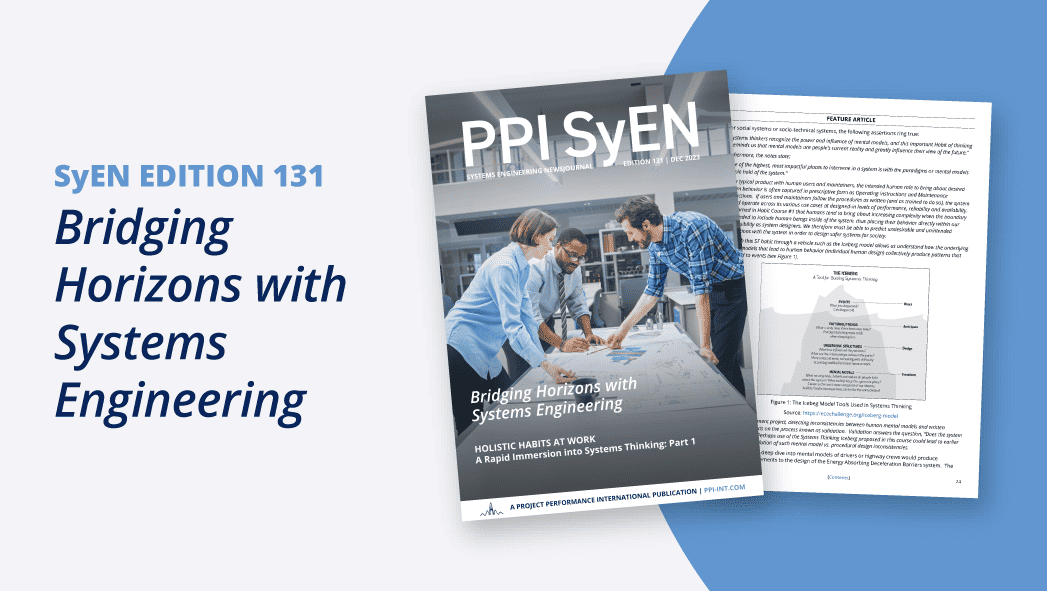IN THIS EDITION
1. Quotations to Open On
2. Feature Articles
2.1 Systems Approaches for Improved Animal Welfare by Isabel Meyer & Leanne Scott
2.2 An Overview of Systems Engineering Educational Programs in Brazilian Defense Structure and an Approach to Accelerate the Development of Proficiencies of Systems Engineers by Luiz Eduardo Nunes de Almeida
3. Additional Articles
3.1 Exploring the Test and Evaluation Space Using Model Based Conceptual Design (MBCD) Techniques by Dr. David Flanigan
4.1 PRESENTATION: The Enormous Future Challenge to Systems Engineering – Artificial Intelligence, 5th Generation Communications, and Aging and Failing Infrastructure
4.2 Systems-Related Specialist Partners Sought for Britain’s East-West Rail Project
4.3 Systems Analysis for a New Arctic
4.4 How can expertise in research integration and implementation help tackle complex problems?
4.5 The Field of Systems Engineering has a High Satisfaction Rate
4.6 KBR and International Council on Systems Engineering Sign Partnership Memorandum
5. Featured Organizations
5.1 Infrastructure Report Card
5.2 International Electrotechnical Commission (IEC)
5.3 International Institute for Applied Systems Analysis
6. News on Software Tools Supporting Systems Engineering
6.1 “Product-centric Development is Dead: Long Live Product Line Engineering” by Alwyn Smit
6.2 WEBINAR: ‘4 Ways to Put Your Systems Engineering Model to Work’ by Vitech
7. Systems Engineering Publications
7.1 Disciplinary Convergence in Systems Engineering Research
7.2 Approach to Designing Systems for Delivering Value
7.3 The INCOSE-PPI Systems Engineering Tools Database – What’s Coming
7.4 Systems Engineering Pathology: Comprehensive Characterization of Systems Engineering Dysfunction
7.5 Dilemmas in a General Theory of Planning
7.6 Engineer Your Career: A Complete Guide to Landing a Job in Engineering
8. Education and Academia
8.1 New Online Master’s Degree for Creative Problem Solvers Master of Science in Integrated Design, Business, and Technology – University of Southern California (USC) USA
8.2 Indian Railways has launched a Joint Master’s Program with the University of Birmingham
8.3 Top Ten Robotics Engineering Universities and Courses in 2020
8.4 Applications Open for a Human-Machine Interactions Assistant Professor at Carleton University in Ottawa, Ontario
9. Some Systems Engineering-Relevant Websites
10. Standards and Guides
10.1 International Electrotechnical Commission Standards
10.2 PikeOS 5.0 RTOS Targets Safety and Security-critical Systems
10.3 Industry Standard Guidelines for EVMS (2019)
11. Some Definitions to Close On
11.1 Vision
11.2 Capability
11.3 Technical Standard
11.4 Due Diligence
12. Conferences and Meetings
12.1 Global Digital Development Forum – Starts 6th May
13. PPI and CTI News
14. PPI and CTI Events
15. Upcoming PPI Participation in Professional Conferences
1. Quotations to Open On
“Physical concept drives logical design. If it doesn’t, we have an exercise in fantasy.”
Robert John Halligan
“Always plan ahead. It wasn’t raining when Noah built the ark.”
Cardinal Richard Cushing
“One of the nicest things about not planning is that failure comes as a complete surprise.”
Unknown
2. Feature Articles
2.1 Systems Approaches for Improved Animal Welfare
by
Isabel Meyer & Leanne Scott
April 1, 2020
Father Brown laid down his cigar and said carefully:
“It isn’t that they can’t see the solution. It is that they can’t see the problem”. (G K Chesterton, 1929)
Editor’s Note: This article uses the example of animal welfare in a resource-constrained environment to discuss and illustrate the systemic elements of a problem, and the need for holistic solutions in such complexity.
Abstract
As problems become increasingly complex, it is evident that conventional approaches are no longer effective in delivering sustainable solutions. By reducing a problem to something that is manageable and has a feasible solution, one may succeed in designing partial solutions, of which the impact may range from partial usefulness to doing more damage than good. While conventional approaches are appropriate for a certain subset of problems, the complex societal problems of today require holistic approaches for lasting solutions. This article uses the example of animal welfare in a resource-constrained environment – a complex but neglected problem – to discuss and illustrate the systemic elements of the problem, and the need for holistic solutions in such complexity. The purpose is to raise awareness and stimulate interest, rather than to provide ready-made solutions. Systems engineers are invited to engage beyond traditional approaches, and to consider systems where their socio-technical nature is a key consideration in success or failure.
1. Introduction
Traditional approaches have seen scientists and engineers trimming down problems to manageable proportions, and developing solutions accordingly – and this has worked well. We have built the bridges, put people on the moon, designed the smart computer systems, developed the vaccines, embraced the concept of the fourth industrial revolution, and generally moved society forward, one innovation at a time. However, as problems became more complex, the tools became more blunted to the scope and size of this complexity.
As long ago as 1967, the design theorist Horst Rittel coined the term “wicked problem” (nowadays termed “messy” problem) to refer to “that class of social system problems which are ill-formulated, where the information is confusing, where there are many clients and decision makers with conflicting values, and where the ramifications in the whole system are thoroughly confusing” (Churchman, 1967: B141). In the December 1967 issue of Management Science, systems scientist C. West Churchman responded to Rittel’s definition, opened the debate of morality in solving problems, and explored the rights and wrongs of trimming a problem so that it is possible to arrive at a feasible solution; in his words, “taming the growl” while still leaving “the beast as wicked as ever” (Churchman, 1967: B142).
More than five decades on, it should be difficult for any analyst, researcher, scientist, or engineer not to comprehend the necessity for holistic approaches to problem solving, and of focusing on the whole beast, rather than comfortably reducing it to a conceptualization that will merely “tame the growl”. Systemic problems are abundant, and in societies where we are increasingly advancing technology but not equally our levels of education, where some have unlimited access to resources and others not, and where daily lives across all these divides are intimately intertwined, the opportunities are endless to develop solutions that tame the beast rather than the growl.
This article explores, with animal welfare as focal point, the manner in which systems approaches can aid in bringing perspective and facilitating improvement in complex systems. First, it defines and interprets the problem by conceptualizing welfare as a messy problem with unique challenges. Then, it emphasizes the systemic elements of the problem, and the value of resolving them. Finally, it describes the systems problem from the perspective of two animal welfare non-governmental organizations (NGOs), to highlight the complexities faced by an animal welfare organization in a resource-constrained area in Cape Town, South Africa. The purpose is to point towards complex problems and possible systems approaches that can influence their status, rather than to provide ready-made solutions or approaches - which would, of course, belie the very essence of the problem.
- Animal welfare at the periphery of the system
Governmental and non-governmental organizations that focus on welfare, be it human or animal, attempt to provide for needs that are not catered for by the formal economy, market forces, and formal social systems (e.g., Dar, 2015). These organizations attempt to improve lives, based on a mandated or perceived understanding of a societal need. In South Africa, as in many developing countries, the need for welfare support seems never to be fulfilled. With an increasing population and shrinking economy, the formal systems are increasingly at a loss to support livelihoods.
Similarly, while governmental systems are designed and mandated to address socio-economic gaps through policy and tax funding, they are failing for many reasons. These include confusion about the underlying welfare approaches and theory, unbalanced funding priorities, lack of capacity to implement, and limited institutional capacity (Patel, 2015). Corruption and poor management further deplete resources in an already constrained environment, while available research and the capacity to innovate is limited (Kareithi and Lund, 2008; Patel, 2015).
It is into this gap left by formal systems that well-meaning individuals step to establish non-governmental, non-profit organizations to fulfil a perceived need. While such well-meaning and driven intent has the capacity to deliver impact, the sustainability of the organizations is of concern (e.g., Hayman, 2016). These dynamics result in a landscape where formal and informal systems co-exist and compete for limited resources, and where impact is sub-optimal.
The welfare system can be conceptualized as a system comprised of formal and informal (or less formal) actors, where formal actors refer to the (governmental) institutions that are mandated by law to deliver a specific welfare role. Examples include Departments of Social Development, and the national and local Societies for the Protection of Animals.
Informal actors refer to the plethora of non-governmental organizations that aim to meet welfare needs, ranging from institutions with a mostly local focus, such as human and animal shelters and soup kitchens; regional or sectorally focused organizations such as those focusing on drought relief; and NGOs with a national footprint, some of which serve as integrating bodies across smaller organizations within the same sector. The level of sophistication varies significantly across informal actors, as does the capacity to solicit funding, manage operations, and plan for impact.
Some characteristics of formal and informal welfare systems are summarized in Table 1, based on the experience of the authors. This summary reflects two extremes of an inadequate system, namely, a formal system that is constrained in its capacity to deliver within a broader national resource and policy context, and an informal sector that works hard to deliver within resource constraints, but without the broader guidance of an enabling regulatory framework.
Table 1: Characteristics of the formal and informal welfare support systems
|
Formal system |
Informal system |
|
|
Philosophy |
Defined by national policies |
“Do good” |
|
Objective |
Deliver on mandate, according to national priorities and policies |
Alleviate a perceived need |
|
Scope |
Predominantly national, regional |
Mostly local, some regional and national |
|
Structure |
Hierarchical |
Organic |
|
Regulation and freedom to act |
National policy and legal frameworks |
Legal frameworks, with no additional regulation |
|
Resources |
Constrained by national priorities and budget allocations |
Constrained by ability to secure donor funding |
|
Partnerships and capacity to collaborate |
Some collaboration within like-minded organizations in the NGO sector Significant competition for resources within the NGO sector Limited cooperation between the NGO and government sector |
|
|
Key challenges |
Adequate resources Delivery on mandate |
Adequate resources Pressure to fulfil societal need Sustainability |
|
Operational approach |
Work within rules, regulations, and constraints |
“Work harder” “Stay afloat” |
|
Unresolved concerns |
Service delivery |
Sustainability Ability to reflect strategically on impact Ability to secure funding |
Improvement of the welfare system could be characterized as a “messy problem”, as first defined by Webber (1967), and subsequently formally described by Rittel and Webber (1973) in the context of social policy planning. In their definition, wicked or “messy” problems are complex, do not have clear-cut solutions, are difficult to solve due to conflicting and changing requirements, and have complex interdependencies. Webber’s definition was embraced to highlight how conventional approaches have failed to address management problems (Churchman, 1967), which opened the debate for more holistic problem solving approaches, including problem structuring and systems conceptualizations. Table 2 interprets the opportunity for enhanced welfare performance against the characteristics of a “messy” problem.
Table 2: Characteristics of the formal and informal welfare support systems
|
Characteristics of a “messy” problem (Hevner et al., 2004) |
NGO welfare sector problem & solution environment |
|
|
Ill-defined |
Unstable requirements and constraints based upon ill-defined environmental contexts |
Ill-defined, poorly understood goal to ‘do good’ Ambitious goals against overwhelming demand Differing cultural contexts, possible mismatch between need and intent |
|
Complex |
Complex interactions among the subcomponents of the problem and its solution |
Multiple funders, changing priorities Dependency on donors for resources Complex and poorly understood impacts |
|
Flexibility and human abilities |
Inherent flexibility to change design processes and design artefacts A critical dependence upon human cognitive abilities (e.g., creativity) for effective solutions. A critical dependence upon human social abilities (e.g., teamwork) for effective solutions. |
Freedom to design own processes within relatively little regulations Facilitate ongoing operations against unstable resource availability Resource-constraints: limited skills; limited organizational capacity; limited access to technology |
- Systems approaches to tame the beast: how does it help to “think system”?
- What is the systems problem?
The problem as sketched in the previous sections is one with multiple dimensions, and does indeed fulfil Rittel and Webber’s (1973) definition of a “wicked” problem. In this environment, what new perspectives can systems thinking bring to take the evolution of this problem forward? In the conceptualization of Ackoff, a pioneer of systems thinking, the discipline is characterized by the following:
- The systems approach to problems focuses on systems taken as a whole, not on their parts taken separately. Such an approach is concerned with total ystem performance even when a change in only one or a few of its parts is contemplated because there are some properties of systems that can only be treated adequately from a holistic point of view. These properties derive from the relationship between parts of systems: how the parts interact and fit together (Demirkan et al., 2011:274)
- A system is never the sum of its parts; it’s the product of their interaction (Hunter, 2019)
- The performance of a system doesn’t depend on how the parts perform taken separately, it depends on how they perform together – how they interact, not on how they act, taken separately. Therefore, when you improve the performance of a part of a system taken separately, you can destroy the system. (Hunter, 2019)
It is in these and similar conceptualizations where the key to improved animal welfare lies.
At the organizational level
Welfare organizations, as outlined in this article, often evolve from the need of a “Samaritan” to “make things better”. While the deeper personal motivations are not relevant to our discussion, this dynamic often plays out in well-meaning individuals who soon find themselves with the task of managing an organization, with very limited resources and very large ambitions, from the basis of no or very little organizational experience. This, in turn, plays out in a daily struggle to feed an ever-growing population of sheltered animals, fatigue from responding to a never-ending need, and, sadly, relatively little impact.
Figure 1: Welfare organizations face complex challenges in resource-constrained environments
The tragedy and the opportunity lies therein that a lack of a considered approach prevents actors from making that long-lasting impact that they so keenly desire to make. When engaging these “Samaritans” in a discussion about purpose, impact, and success, it quickly becomes clear that their efforts mostly revolves around “saving the animal”, with little or no consideration of what this may mean in a broader system of animal welfare. The almost obsessive focus on a small part of the system, without an understanding of the broader “system” within which it functions, leads at best to limited impact, and at worst adds to the problem when animals are hoarded and kept in conditions that are not conducive to good welfare.
Here, Ackoff again adds a valuable insight, in stating that:
Improving the performance of the parts of a system taken separately will not necessarily improve the performance of the whole. (Ackoff, n.d.)
In essence: by improving the plight of a few individuals, in a captive environment that has high resource demands, one does not necessarily contribute to resolving the broader systemic problem that generates this ongoing need for care.
At the national level
As indicated in Section 2, national welfare systems are extremely limited in coping with demand, given their limited resources. However, ad hoc welfare organizations are often seen as a nuisance rather than a potentially valuable resource, and tend to be considered as part of the problem that needs to be policed for animal welfare transgressions.
Figure 2: The number, location, capacity, maturity, and sophistication of shelters are not known
In this context, systems approaches could contribute:
- At the firm level, by developing a systemic understanding, guiding organizations towards seeing their role in a bigger part, clarifying organizational objectives as a contributor to a bigger system, and influencing decisions towards broader impact rather than “saving the individual”; and
- At the national level, by conceptualizing a national capacity for welfare across organizational boundaries, visualizing the collective national capacity, identifying stakeholders, and making linkages visible that are required to improve the collective capacity for animal welfare.
3.2 Case examples
Two cases in the animal welfare sector, based in the Western Cape, were used to explore the challenges and to understand the priorities of welfare organizations in resource-poor environments. Both organizations are mature, and represent “best practice” in terms of animal welfare organizations, and both reflect the operations of long-standing (15-20 years) establishments in under-resourced communities that provide veterinary care, shelter services, and education. Table 3 summarizes the cases, based on marketing material of the participating organizations.
Table 3: Case characteristics
|
Case 1 |
Case 2 |
|
|
Established 1999 |
Established 1996 |
|
|
Purpose |
To bring relief to animals in distress, whether through intervention, education, medical assistance or rehoming |
Primary veterinary healthcare services |
|
Vision |
Continuous improvement and expansion in order to rescue, rehabilitate, re-home, or re-unite every domestic animal that has nowhere else to turn and is in need of a champion |
Companionship and Community Care for every animal |
|
Mission |
Rescue, rehabilitate, and rehome domestic animals, and provide veterinary services to local communities Re-unite lost animals with their guardians, and carry out a wider program of veterinary outreach and humane education in our communities, that promotes the responsibility and burden of care we have towards the animals that share our lives |
Enhancing wellbeing for animals and their community through low cost veterinary health care, education and partnerships Strong focus on community empowerment and education, focus on understanding and embracing community’s needs, gaining respect and trust. |
|
Beneficiaries |
Communities in the False Bay area |
Communities on the Cape Flats 31% of households have an income below R 1845 / month Estimated 133 000 companion animals in area |
|
Size of organization |
Approximately 50 staff members, approximately 300 animals in care |
Approximately 25 staff members Treat 700-1000 animals per month |
|
Delivery mechanisms |
Shelter; Veterinary clinic and mobile units; Feral cat project; Sterilization campaigns |
Veterinary clinic and mobile units; education clinics; stray adoptions; ambulance; school education program |
|
Donors & Income sources |
Individuals and corporates Charity shops |
International and local donor organizations, corporates, individuals Vetshop; nursery |
|
Key challenges |
Continued donor funding; Resources for expansion; Own facilities |
|
The two cases reflect operations that have delivered on a real need over an extended period of time. The key challenges of both organizations remain continued funding to sustain operations, and funding to expand operations to provide for an ever-growing need. While the organizations have, in essence, proven sustainability, they remain fragile in their dependence on donor funding. Funding sources are varied, ranging from large international donors that make decisions based on strategic funding priorities, to corporates who sponsor products, and individuals who participate in funding drives, volunteer their time, or donate on an ongoing basis.
Interviews revealed the same strategic needs, namely, to convince donors to commit to ongoing support in an environment of shifting funder priorities and a focus on human rather than animal health interventions. These shifting priorities, and a focus on the interdependence of animal healthcare and community well-being, open the opportunity to demonstrate human health and wellbeing impacts through enhanced companion animal health and welfare — as is reflected in the emerging One Health/One Welfare field of study (Jordan & Lem, 2014).
At a tactical or project-by-project level, organizations need to demonstrate the positive impact of specific programs—for example, the impact of a deworming program, so as to convince product owners to sponsor deworming medicine.
At an operational level, the need is to ensure a positive cash flow, to deliver a service with limited resources under extreme demand, and to accommodate unforeseen events (e.g., robberies). In spite (or perhaps due to) the resource-constrained environment, both organizations seem to have structures and systems in place that facilitate ongoing and well-managed operations. However, operational challenges remain. Both organizations were experiencing veterinary staff turnover at the time of the initial engagements. In one case, operations were supported by a well-maintained records system. In the other, while information systems were in place and evolving, the majority of records were paper-based.
The opportunity to enhance sustainability is significant. In the face of an ongoing need, the stability and organizational excellence of organizations that ‘bridge the gap’ is paramount. Based on the case overviews, the following objectives can be defined:
- Develop an understanding, and demonstrate the influence of, the welfare organization as an actor in the community;
- Demonstrate the impact of specific interventions;
- Elicit an understanding of the community’s needs, as clients of the welfare organization;
- Find mechanisms to reduce the ongoing pressure on welfare organizations by reducing the community’s ongoing need for welfare support;
- Aid the development of welfare organizations towards excellence and sustainability; and
- Understand the interactions and interplay between the community, NGOs, and government, and find opportunities to develop partnerships for improved performance.
Based on the above, the following systemic questions can be identified:
|
Objective |
Main focus |
Some questions |
|
|
organizational level |
Understand the welfare organization as actor in the community |
Strategic |
|
|
Elicit an understanding of the needs of the community as clients of the welfare organization |
Strategic, tactical |
|
|
|
Demonstrate the impact of specific interventions |
Strategic, tactical |
|
|
|
Find mechanisms to reduce the need for ongoing support |
Tactical |
|
|
|
Enable the development of the welfare organization as influencer of the community, to ensure ongoing excellence |
Tactical, operational |
|
|
|
national level |
Influence the sector for improved performance |
Strategic |
|
|
Engage and collaborate with informal role players as partners for improved welfare |
Tactical |
|
-
- What tools or approaches do we have?
The welfare sector, with organizations of varying maturity and sophistication, provides the opportunity to develop excellence through problem structuring, strategy development, process optimization, and others. At the sector level, the opportunity exists to identify gaps, characerize the enabling environment, define entities to strengthen performance, support innovation and learning, and accelerate organizational growth.
A number of systems approaches, in their broadest sense, could be employed towards the above goals. Some examples are summarized below – note that these serve as examples, and are not intended to be an exhaustive list:
|
Tool or approach |
Summary |
Application in this context |
|
Soft systems methodologies (SSM) (Checkland, 1981) |
A learning or inquiring system which uses systems models to understand and intervene in real-world complexities, based on 7 steps. |
Problem structuring, developing clarity of purpose of the welfare organization, understanding system boundaries and the scope that the organization wants to address, identifying stakeholders |
|
Socio-technical systems (Trist and Bamford, 1951) |
The interrelatedness between the social and technical aspects of an organization, or the interaction between societal structures and human behavior |
Understand the ways in which the community would interact with welfare organizations, for what purpose, and how organizations could best structure themselves to deliver impact |
|
Critical systems thinking (Jackson, 1985) |
Analysis of complex societal problems and the interventions aimed at solving them |
Select the appropriate combination of systems thinking techniques to model this problem and provide decision support |
|
Social network mapping |
Map the interaction between various role players in the community, so as to understand the interactions between key role players |
Understand the stakeholders and key role players that affect the welfare organization, and their relationships and power bases |
|
Systems dynamic models |
Model and simulate complex issues and problems, assess the impact of interventions, illustrate and evaluate the impact of decisions, understand the drivers of system behavior. |
Discuss the role of the organization in the community, define its objectives, and simulate the effect of different decisions (e.g., the effect of investing in different interventions) on the overall welfare of the community’s animal population |
|
and others… |
-
Summary and Conclusions
As populations grow and economies fail to support this growth, the formal economic and social systems will increasingly fail to support livelihoods. In this environment, benefactors will always seek to improve the situation, and will initiate interventions from a basis of limited resources and experience, without the benefit of structured introductions to learning and development. This paper interprets the various actors in welfare as a system of formal and informal players, who work towards a perceived common goal in an environment where resources are limited and where systemic drivers are manifesting in an ever-increasing need. The collective system (of formal and informal players) is unstructured, with a specific need for professionalism and sophistication in the NGO sector. The discussion elicited needs, based on the authors’ experience, prior research, and a brief review of two cases in the animal welfare sector.
This preliminary analysis pointed towards a portfolio of work that could be structured to address pressing needs. While solutions may seem obvious and elementary, the scope for such solutions to enhance performance is testament in itself of the relative immaturity of the sector. Further, given its fragmented nature, the sector could benefit from central platforms and role players that aim to improve formality and enhance performance. The discussion intended to highlight and emphasize the systemic nature of the problem under consideration, and to point towards some systems approaches that could be employed to guide approaches that are intended to influence complex societal problems for the better. It invites systems engineers to think beyond the toolset that they are familiar with, and find ways to apply this to problems where human interaction is a key consideration in overall system performance.
Epilogue
This article represents an exploration into the application of systems methodologies to problems that are beyond those traditionally addressed in the systems engineering context. It provides the opportunity for systems engineers to consider problems beyond the traditional, and to think about the broader application of well-known and well-used tools.
Numerous drivers are at the root of increasing complexity in societal contexts, and problems can be expected to increasingly require holistic approaches. The interface between humans, their environment, and (in this case) animals presents the complexity that should be modeled and managed. This provides the opportunity for embracing the systems approaches and theories that have evolved over the past few decades in response to approaches that are considered as insufficient, but also leaves the field open for new approaches and theories for managing the complexity that arises at the interfaces between different worlds.
List of Acronyms Used in this Paper
Acronym Explanation
NGO Non-governmental Organization
SSM Soft systems methodology
Acknowledgements
The authors are grateful for the time and engagement of the following role players, for making the exploration into this relatively uncharted field possible:
TEARS Animal Rescue and the Mdzananda Animal Clinic, for sharing their stories and participating in our research.
The Department of Statistics, University of Cape Town, for hosting the research, and Erahim Steenkamp and Mahdi Marcus, for developing exploratory system dynamic models.
Dr Chantelle Murray of the One Revolution foundation, for highlighting the needs of animal welfare organizations, for making research accessible, and for connecting us to the participating welfare organizations.
References
Ackoff, R. A Lifetime of Systems Thinking.
https://thesystemsthinker.com/a-lifetime-of-systems-thinking/
Churchman, C.W. “Wicked Problems”. Management Science 14(4), Application series, December 1967.
Dar, F. “Emerging role of NGOs in the world’s socio-political affairs”. International Journal of Peace and Development Studies, 6(1), pp. 1–9, 2015.
Demirkan, H., James C. Spohrer, J.C., Krishna, V. The Science of Service Systems. p. 274. Springer, 2011. ISBN:978-1-4419-8269-8
Hayman, R. “Unpacking civil society sustainability: looking back, broader, deeper, forward”. Development in Practice, 26(5), pp. 670–680, DOI:10.1080/09614524.2016.1191439.
Hevner, A.R., March, S.T., and Park, J. “Design Science in Information Systems Research”. MIS Quarterly, 28(1), pp. 75–105, 2004.
Jackson, M. 1985. “Social Systems Theory and Practice: The Need for a Critical Approach.” International Journal of General Systems 10: 135-151.
Jordan, T. and Lem, M. “One Health, One Welfare: Education in practice Veterinary students’ experiences with Community Veterinary Outreach”. Canadian Journal of Veterinary Science, 55(12), pp. 1203–1206, 2014.
Kareithi, R.N.M. and Lund, C. Review of NGO performance research published in academic journals between 1996 and 2008, South African Journal of Science, 108 (11/12).
Murray, C. Governance to promote donor investment: A case study of animal shelters. PhD thesis, Department of Industrial Psychology and People Management. Johannesburg: University of Johannensburg, 2018.
Patel, L. Social welfare and social development, 2nd Edition, Oxford: Oxford University Press, 2015.
Rittel, H.W.J. and Webber, M.M. Dilemmas in general theory of planning, Policy Sciences 4, pp. 155–169, 1973. doi 10.1007/bf01405730.
Trist, E.L., and Bamforth, K.W. “Some Social and Psychological Consequences of the Longwall Method of Coal-Getting: An Examination of the Psychological Situation and Defences of a Work Group in Relation to the Social Structure and Technological Content of the Work System”. Human Relations 4(3). DOI: 10.1177/001872675100400101.
About the Authors
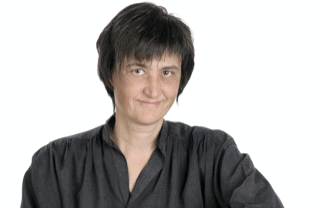 Isabel Meyers is an Operations Researcher and veterinarian from South Africa, with extensive experience in modeling, research, and analysis of complex systems. Her consulting portfolio includes modeling and analysis of transport and logistics channels, business and organizational systems, and development initiatives. Her interests are in improving the impact of development and change processes, through the application of systems analysis and decision modeling. This includes the evaluation of the impact of interventions on organizational objectives and performance. A specific interest is the design of rural economic development projects and the associated project structures in such a way that sustained benefit is delivered within communities. Her work includes assessment and improvement of animal welfare interventions in communities, from a One Welfare/One Health perspective. Isabel holds PhD (Information Systems, MBA, and BVSc degrees.
Isabel Meyers is an Operations Researcher and veterinarian from South Africa, with extensive experience in modeling, research, and analysis of complex systems. Her consulting portfolio includes modeling and analysis of transport and logistics channels, business and organizational systems, and development initiatives. Her interests are in improving the impact of development and change processes, through the application of systems analysis and decision modeling. This includes the evaluation of the impact of interventions on organizational objectives and performance. A specific interest is the design of rural economic development projects and the associated project structures in such a way that sustained benefit is delivered within communities. Her work includes assessment and improvement of animal welfare interventions in communities, from a One Welfare/One Health perspective. Isabel holds PhD (Information Systems, MBA, and BVSc degrees.
 Leanne Scott is an Associate Professor in the Department of Statistical Sciences at the University of Cape Town (UCT). She obtained her PhD in 2004 with a thesis entitled Legitimacy and Decision Making in Developmental Local Government: Participative Multi Criteria Decision Analysis in Stellenbosch. She teaches postgraduate courses in Decision Modeling as well as Problem Structuring, both of which address methods of supporting decisions with multiple objectives, dimensions and/or stakeholders as well as the incorporation of subjective information. Her applied research has encompassed a diversity of issues including Integrated Development Planning (local government), poverty studies, development of ecological indicators and problem gambling.
Leanne Scott is an Associate Professor in the Department of Statistical Sciences at the University of Cape Town (UCT). She obtained her PhD in 2004 with a thesis entitled Legitimacy and Decision Making in Developmental Local Government: Participative Multi Criteria Decision Analysis in Stellenbosch. She teaches postgraduate courses in Decision Modeling as well as Problem Structuring, both of which address methods of supporting decisions with multiple objectives, dimensions and/or stakeholders as well as the incorporation of subjective information. Her applied research has encompassed a diversity of issues including Integrated Development Planning (local government), poverty studies, development of ecological indicators and problem gambling.
2.2 An Overview of Systems Engineering Educational Programs in Brazilian Defense Structure and an Approach to Accelerate the Development of Proficiencies of Systems Engineers
by
Aeronautics Institute of Technology (AIT) and Avibras Indústria Aérea e Naval S.A.
February 19, 2020
Abstract
Defense Engineering is the engineering area that deals with all branches related to the defense industry and defense systems. It is a multi- and inter-disciplinary enterprise that develops in a transdisciplinary environment, integrates knowledge originating from engineering, physics, chemistry, biology, and materials science, and is configured as a complex area that includes aspects of analysis and synthesis related to development, design, optimization, integration, certification, evaluation, operations, and logistics of systems applied to defense. Defense Engineering integrates knowledge from various branches of Engineering and Science, with a focus on basic and applied research, aimed at the development of defense systems. Systems engineering (SE) is usually defined in terms of the activities that are used in the field: mission or purpose definition, requirements engineering, system architecting, system implementation, technical analysis, technical management and leadership, scope management, and verification and validation (Madni, 2017).
The purpose of this article is to provide an overview of the main initiatives that encompass systems engineering in Brazil related to Defense and to report on a simplified model that has the potential to strengthen the development of systems engineers that could be pursued in the coming years (Davidz, 2007). Bibliographic research was carried out with several technical articles from different sources for this work. Articles that present a thinking model of senior systems engineers and how they were trained are sparse. I have utilized the approach proposed by Davidz et al; his doctoral dissertation (Davidz, 2006) sought to address this problem by studying how to enable systems thinking to accelerate the development of senior systems engineers.
A technical article that provided a basis for this work is a paper written by Hutchison et al concerning Atlas. Atlas is a theory centered on creating effectiveness in systems engineers. The primary data so far on which Atlas is based come from the U.S. defense community; however, indications are that the theory is applicable to other business sectors as well. The theory is based primarily on qualitative analysis of interviews with engineers from organizations in the U.S. DoD, defense industrial base, and commercial industry. Atlas identifies the key characteristics of systems engineers, explains what promotes and inhibits their effectiveness, and identifies how organizations are attempting to improve effectiveness of their systems engineering workforce.
In order to provide these values, system engineers must have proficiencies including knowledge, skills, abilities, behaviors, and cognition. The proposal to accelerate the development of Systems Engineers was based on a study made by Heidi et al (Davidz, 2007) and Hutchison (Hutchison, 2016).
Copyright © 2020 by Luiz Eduardo Nunes de Almeida. All rights reserved.
- Introduction
“Engineering Systems is a field of study that takes an integrative holistic view of large-scale, complex, technologically-enabled systems with significant enterprise-level interactions and socio-technical interfaces” (Rhodes, 2004). “The function of Systems Engineering is to guide the engineering of complex systems. Systems engineering is focused on the system as a whole and it emphasizes total operation. It looks at systems from the outside, that is, at its interactions with other systems and its environment, as well as from the inside” (Kossiakoff, 2003).
“Systems engineering is an interdisciplinary approach and means to enable the realization of successful systems” (INCOSE 2004). The Evolution of Systems Engineering (Figure 1) provides a brief overview of the origins of the discipline. Note that SE is a young discipline; yet, it has already contributed immensely to solutions needed by society.
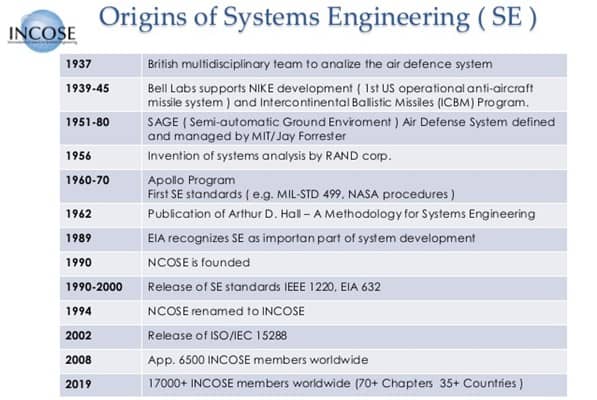
Figure 1: Evolution of the Discipline of Systems Engineering (Delicado, 2020).
Systems Engineering in Brazil was seen as an area of unimportant knowledge a few decades ago. Due to the development of products in the Space areas through the National Institute for Space Research (INPE) and the Institute of Aeronautics and Space (IAE) occurring simultaneously with the growth of companies such as Embraer and Avibras Indústria Aeroespacial, with projects for the Commercial and Defense areas, initiatives were created to improve the knowledge, courses, skills, abilities, and training of professionals to meet this demand.
The main programs in Brazil concerning systems engineering originated in the following Federal institutions:
-
- National Institute for Space Research (NISR)
- Aeronautics Institute of Technology (AIT)
- Military Institute of the Army (MIA)
- Minas Gerais Federal University (MGFU)
- National Institute for Space Research – NISR
The activities concerning space systems at the National Institute for Space Research (NISR) were developed within the scope of Space Technology Engineering (STE) focused primarily at the research and development of engineering and systems of interest to the space area, based on systems engineering concepts. In addition to meeting the Institution’s demands and specific demands of technology companies, courses were created under the responsibility of INPE for transfer of technology to the private sector – these courses were called the Space Engineering and Technology Course (STE). The Space Engineering and Technology Course is formed by several areas of concentration covering, in a complete and detailed way, the entire process involved in the development of space and aerospace and terrestrial engineering solutions, with an emphasis on systems engineering. The purpose of the Space Engineering and Technology Course (STC) is to generate and disseminate unprecedented scientific results at both national and international levels. The Space Sector in Brazil, due to the unique characteristics of its applications, is responsible for a significant part of new developments in the area of systems engineering (NSRI, www.inpe.br/). Thus, it is important for the Brazilian Space Program (BSP) to provide a center that accumulates information concerning systems engineering and develops research in the area, both theoretical and experimental, mainly with regard to its techniques. Another important role for the BSP is the development and dissemination of knowledge through the training of human resources (NSRI).
-
- Aeronautics Institute of Technology – AIT
The Aeronautics Institute of Technology (AIT) currently offers system engineering disciplines for graduation and post-graduation courses in the areas of Mechanics, Aeronautics, Aerospace, Electronics, and Programming Sciences (software). AIT has also been promoting masters and doctoral dissertations in space systems with a strong approach to systems engineering (AIT, www.ita.br/).
-
- Military Institute of the Army – MIA
With the beginning of the teaching activities of the Graduate Program in Defense Engineering (GPDE) in February 2007, the Military Engineering Institute (MIA) seeks to effectively guide its courses and research for the Defense area and for the needs of the Brazilian Army (BA). This objective is in accordance with the guidelines of the Department of Science and Technology (DST) of the Brazilian Army (BA) and with the National Defense Policy, launched in June 2005 by the Ministry of Defense (MoD), regarding the scientific and technological capacity of the Forces Armed and Civil Society (MIA).
-
- Federal University of Minas Gerais – FUMG
The Federal University of Minas Gerais is considered the first university in Brazil to offer a course with content focused on systems engineering. The bases for the courses in Brazil are the INCOSE manuals, the INCOSE Systems Engineering Handbook, INCOSE Technical Publications, Systems Engineering (SE) Journal, Papers & Presentations Library, and SE Standards. The NASA Systems Engineering Handbook and NASA Technical Publications are also used for the courses (The FUMG Website is https://ufmg.br/).
It is important to emphasize that in this article the main initiatives that encompass systems engineering in Brazil related to the Defense area were mentioned in the four topics mentioned above. There are other initiatives in Universities that were not mentioned here.
- Literature Review Concerning the Effectiveness of Systems Engineers
There are limited studies that explore the influence of organizational culture, governance, structure, and workforce composition on the effectiveness of the systems engineering workforce (Hutchison, 2009). According to Nicole et al, Helix is a multi-year project that aims to clarify what makes engineers and systems engineering effective. Consequently, the Helix project aims to investigate the connection between attributes of the work environment and the effectiveness of the systems engineering workforce through the implementation of both qualitative and quantitative research approaches. With insights into effective systems engineers clearly defined, the research now focuses on exploring the characteristics of organizations that impact the effectiveness of systems engineers and how these characteristics lead to an effective organizational systems engineering capability (Hutchison – 2009, Hutchison 2016).
The discipline of systems engineering has been recognized for over 50 years (Frank, 2000 and Goode, 1957). However, some believe that the documentation of SE as a discipline is still overly influenced by the learning of each practitioner during the personal experimentation of a career. The conclusions by each practitioner differ, as shown by the discordant content of SE “standards” and SE certification. Current conflicting standards include ANSI/EIA-632, IEEE-1220, ISO/IEC 15288 in its various versions, the Capability Maturity Model Integration (CMMI), MIL-STD-499C, and others. These standards provide indication of identified best practices that are agreed by the authors of the standards, but it could be concluded that the substantial differences between the standards reflect a lack of overall agreement concerning what constitutes best practice. Other engineering fields do not have this same confusion. Software engineering, for instance, is younger than systems engineering. The term was first used in the 1970s, at least 30 years after the term systems engineering, and yet the field of software engineering is well defined and agreed. One reason for this is that other engineering fields define themselves in terms of the type of product they create. Software engineers create software; electronic engineers create electronics; mechanical engineers create mechanical devices (Frank, 2000 and Goode, 1957).
Defense Engineering is the engineering area that deals with all branches related to the defense industry and defense systems. It is a multi and interdisciplinary enterprise that develops in a transdisciplinary environment, integrates knowledge originating from engineering, physics, chemistry, biology and materials science, and is configured as a complex area that includes aspects of analysis and synthesis related to development, design, optimization, integration, certification, evaluation, operation, and logistics of systems applied to defense. This way, Defense Engineering integrates knowledge from various branches of Engineering and Science, with a focus on basic and applied research aimed at the development of Defense Systems. As systems become more complex, the roles involved in developing and managing such systems also become more complex. Thus, there is increasing interest in educating and training engineering professionals to think more systemically. In particular, there is an increasing need to accelerate the development of senior systems engineers. As new educational degree programs in systems rapidly emerge and as companies scurry to establish systems training programs to meet this need, fundamental questions still remain about how systems thinking develops in engineers.
To better understand the ability of systems engineers to meet these challenges, the Systems Engineering Research Center (SERC), a University-Affiliated Research Center of the US Department of Defense, begun in 2008. The SERC was selected to conduct the Helix Project, which investigates the common characteristics of systems engineers; what makes systems engineers effective and why; and what employers are doing or could do to improve the effectiveness of their systems engineers. The work began with systems engineers in the defense community but has grown to include other industries over time. The goal of Helix is to offer insights into what makes systems engineers effective — insights that can be used to help develop and mature the systems engineering workforce. The research has culminated in Atlas, a theory of what enables systems engineers to be effective. The primary data to date on which Atlas is based comes from the U.S. defense community, but, as described later in this paper, indications are that the theory is applicable to other business sectors as well (Davidz – 2007, Hutchison -2016, and Hutchison – 2009).
- Research Method
As noted above, this work was based on the literature proposed by Hutchison et al (Hutchison, 2016). According to Hutchison, Helix is primarily a qualitative study, with the primary means of data collection being interviews with systems engineers and their peers. Initially, the Helix team focused on a mixed methods approach (Creswell, 2011), combining the development of basic research questions with grounded theory. Grounded theory was developed in the social sciences as a method for developing theory that is systematically gathered and analyzed (Goulding, 2002). This approach allows the data itself to drive points of further inquiry, guide categorization, etc. Rather than initiating analysis with an existing framework, all data are reviewed holistically, and any potential areas of interest are identified.
-
- Interview Approach/Process
Participating organizations were identified based on their reputation for systems engineering or their participation in the systems engineering community. For example, several organizations are corporate members of the INCOSE Corporate Advisory Board (CAB). Organizations had to be willing to make their systems engineers available for the interview, including protecting the identity of all participants.
-
- Dataset
Because the focus was on systems engineers, the sampling distribution included practicing systems engineers, their peers, a mix of program managers, classic engineers such as electrical, mechanical, or software engineers; or individuals in related disciplines. Among systems engineers, the Helix team developed a classification system for identifying the seniority of a systems engineer (Hutchison, 2016).
-
- Qualitative Coding and Analysis
In order to make sense of such a large quantity of data, it is important to use qualitative data analysis, primarily through data coding. Data coding is “a systematic way in which to condense extensive data sets into smaller analyzable units through the creation of categories and concepts derived from the data” (Lockyer, 2004). Codes can be layered, and evolve over time, as explained below. When developing a theory, as in the development of Atlas, categories and codes are generated after examining the collected data, aligning with the grounded theory approach (Bourque 2004). The main type of coding performed for Helix is called “open coding,” the purpose of which is to break down, compare, and categorize data (Corbin, 2015).
-
- The Theory of Effective Systems Engineer
An overview of Atlas is illustrated in Figure 2. The main construct within Atlas is that an individual system engineer who provides consistent delivery of value is an effective systems engineer. This fundamental definition of an effective systems engineer hinges on value, and as illustrated in Figure 2, the organization defines value, meaning the organization defines the value that the systems engineer is expected to provide. The individual systems engineer provides value by performing the roles and positions assigned by the organization. Although the specific values that are most critical are determined by the organization, the most consistently discussed values are described in Section 3.6, below: proficiency is a key enabler for providing value and, therefore, his or her effectiveness. The proficiency model for Atlas is described in Section 3.7. Proficiency is impacted by aspects such as experiences, mentoring, education, and training of an individual.
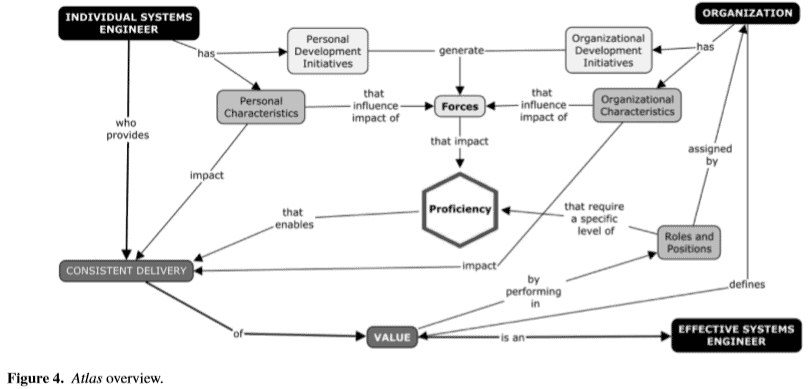
Figure 2: Atlas Overview (Hutchison, 2016).
-
- Value
The value expectation for a systems engineer is context dependent. However, data from the Helix interviews have identified several primary values—the key contributions systems engineers make—along with several enabling values— activities that provide value in and of themselves, but also support delivery of the primary values.
The main values stated by the interviewees were present as follows:
- A primary value that systems engineers provide is maintaining the system vision.
- Another value is translation of technical jargon into business or operational terms and vice versa. This includes translating highly technical information from subject matter experts into common language that other stakeholders can understand and translating operational concepts, customer needs, and customer desires into language that makes sense for engineers and program managers.
- Enabling diverse teams to successfully develop systems. This is enabled by understanding and communicating the system vision to the team, and ensuring that the team is aligned with this vision; helping the team to understand the big picture perspective; and identifying areas of concern for integration.
- Managing emergence in both the project and the system. This is enabled by projecting into the future, which includes staying “above the noise” of day-to-day development issues and identifying pitfalls, and technical problem solving balanced with the big picture perspective.
- Enabling good technical decisions at the system level. This is enabled by the ability to see the vision for the system and communicate that vision clearly; the big picture perspective; a solid grasp on the customer’s needs; being able to bring together a diverse team of engineers and subject matter experts; and a systems engineer’s problem-solving abilities— particularly the ability to focus on root versus proximal cause.
- Supporting the business cases for systems. This is enabled by balancing traditional project management concerns of cost and schedule with technical requirements and understanding the position of a system within the organization or customer’s portfolio and communicating this to the team.
Expected values may differ depending on position, organization, etc., but the list provided above reflects the most commonly cited values for systems engineers across the interviewees.
-
- Proficiency
During Helix team interviews, participants discussed critical knowledge, skills, abilities, behaviors, and patterns of thinking or abilities to learn—cognitions—that are critical to the development of systems engineers – the Helix team calls these “proficiencies”. The overarching proficiency of a systems engineer is defined by his or her ability within six proficiency areas, which are groupings of related knowledge, skills, abilities, behaviors, and/or cognitions. Proficiency areas are further divided into categories. An overview of the proficiency model is provided in Figure 3. These proficiency areas were identified based on the data collected through Helix interviews and are described further below. The proficiency areas are a mix of technical content related to engineering in general, systems engineering-specific content, and critical non-technical skills that enable systems engineers to work with and lead others. The proficiency areas that focus on working with technology—Math/Science/General Engineering, System’s Domain and Operational Context, and Systems Engineering Discipline—were seen as important foundations for systems engineers to understand the systems being created and the work done by other engineers across diverse teams. However, chief systems engineers and non-systems engineers consistently cited the proficiency areas that focus on working with people—interpersonal skills and technical leadership— as areas where individuals must excel to be effective.
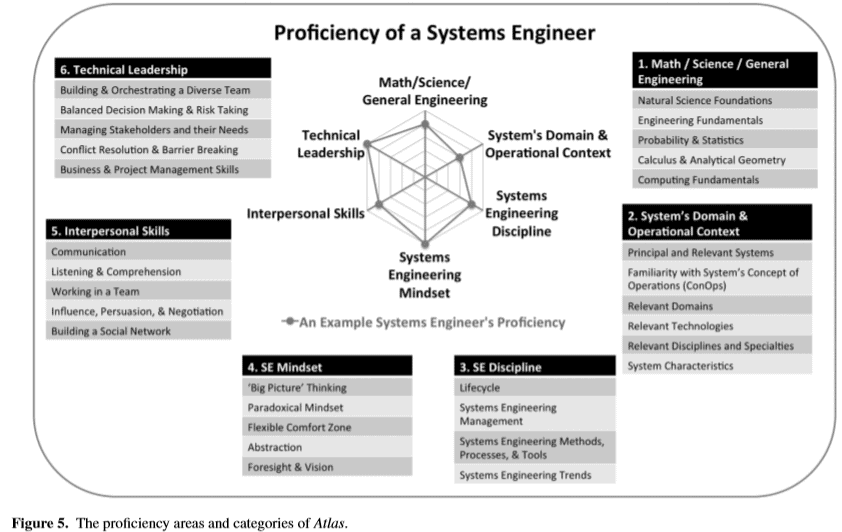
Figure 3: The Proficiency Areas and Categories of Atlas (Hutchison, 2016).
-
- Implementation
Several organizations have reported using Atlas to define boundaries for systems engineers better, to identify organizational initiatives that could help systems engineers grow, and to begin examining the proficiency of their SE workforce. A useful way to utilize the proficiency model provided in Figure 3 is to compare the desired and current proficiency levels for a specific position or seniority level. A notional example of how this is done is shown in Figure 4.
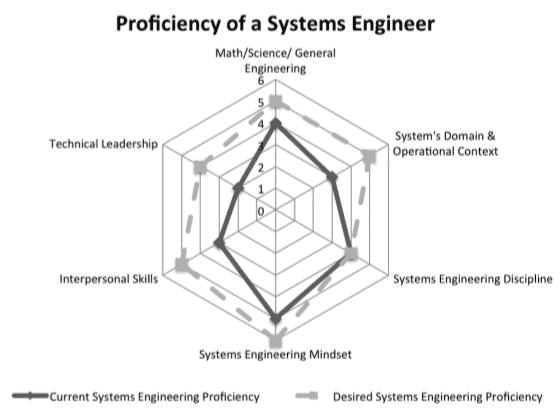
Figure 4: Use of Atlas for workforce development—comparison between desired/required proficiency and an individual’s current proficiency level (Hutchison, 2016).
-
- Implications
The development of senior systems engineers can be accelerated by efficient and effective systems thinking development. The results of this research study suggest multiple ways to enable systems thinking development. Though many companies are resorting to training classes to answer their shortage of systems professionals, the data in the study show the importance of experiential learning. In addition, the data show the importance of certain individual characteristics and a supportive environment to enable systems thinking development. The research results translate into specific implications for government, industry, and academia (Davidz, 2007).
Government agencies can accelerate the development of senior systems engineers by providing incentives to promote strong systems thinking, adjusting policies to emphasize experiential learning for systems thinking development, providing more programs and opportunities for engineers to develop systems thinking when possible, promoting research on the mechanisms for effective systems thinking development, and encouraging systems programs that teach systems skills and systems thinking. Government agencies can encourage systems programs that teach systems skills and systems thinking. These programs can help engineers to understand the componential, relational, contextual, and dynamic elements of systems (Davidz, 2007).
There are implications of this research for industry as well. Industry can structure systems thinking interventions to emphasize experiential learning, offer systems programs to teach systems skills and systems thinking, filter and foster identified individual characteristics in systems organizations, provide an environment supportive to the development of systems thinking, and clearly communicate how the strength of systems thinking is assessed. One of the key findings of the study is the importance of experiential learning for developing systems thinking. Companies can structure systems thinking interventions to emphasize experiential learning. Training courses can be coordinated with work tasks to underscore key learnings. Finally, organizations can communicate clearly how the strength of systems thinking is assessed.
Similarly, there are implications of this research for academics. Academics could offer systems programs to teach systems skills, use feedback mechanisms to continually improve systems programs and systems courses, structure programs and courses to emphasize experiential learning, structure courses to promote systems thinking by emphasizing context and knowledge integration, and continue research on the mechanisms for effective systems thinking development. There are a growing number of systems educational programs; however, to design these programs most effectively, a considerable amount of research still needs to be performed to understand how systems thinking actually develops in engineers. Better understanding of the mechanisms that effectively produce systems thinking will increase the impact of these educational programs (Davidz, 2007).
Summary of the Research
This methodological research project sought to understand better how “systems thinking” actually develops in engineers. Senior systems engineers were studied to understand better how they developed systems thinking, and information was collected on company procedures for developing systems engineers. Using interviews and survey data, comparisons can be done with different engineers of different defense companies. The data can show the importance of experiential learning. In addition, certain individual characteristics enable systems thinking development in engineers, and a supportive environment is also important. It is not surprising that a systems approach is needed to develop systems skills, where individual characteristics and experiential learning are aligned with a supportive environment. This study enhances understanding of actual mechanisms that develop systems thinking, and this enhanced understanding can be used to design more efficient and effective interventions to accelerate the development of Systems Engineers. Enhanced understanding of the current mechanisms that effectively produce systems skills provides a guide for the more efficient development of senior systems professionals in industry, government, and academia. We recommend that it be utilized by Brazilian Defense companies.
List of Acronyms Used in this Paper
Acronym Explanation
AIT Aeronautics Institute of Technology – Brazil
BA Brazilian Army
BSP Brazilian Space Program
CAB Corporate Advisory Board
CMMI Capability Maturity Model Integration
DoD Department of Defense
DST Department of Science and Technology –
FUMG Federal University of Minas Gerais – Brazil
GPDE Graduate Program in Defense Engineering – Brazil
INCOSE International Council on Systems Engineering
MIA Military Institute of the Army – Brazil
MoD Ministry of Defense – Brazil
NISR National Institute for Space Research – Brazil
SE Systems Engineering
SERC Systems Engineering Research Center
STE Space Technology Engineering – Brazil
UARC University Affiliated Research Center
References
Aeronautics Institute of Technology, AIT, Brazil, website http://www.ita.br/
Bourque L. B., “Coding.” in M.S. Lewis-Beck, A. Bryman, and T.F. Liao (Editors), The Sage Encyclopedia of Social Science Research Methods, v.1, Sage, Thousand Oaks, Calif, pp.132– 136, 2004.
Corbin J. and Strauss A., “Basics of qualitative research: Techniques and procedures for developing grounded theory”, Sage Publications, Thousand Oaks, CA, 2015.
Creswell J.W. and Plano C.V.L., “Designing and conducting mixed methods research”, 2nd Ed, Sage, Thousand Oaks, CA, 2011.
Davidz Heidi L., “Enabling systems thinking to accelerate the development of senior systems engineers”, Ph.D. dissertation, Engineering Systems Division (ESD), Massachusetts Institute of Technology, Cambridge, MA, 2006.
Davidz, Heidi L., and Nightingale Deborah J., “Enabling Systems Thinking to Accelerate the Development of Senior Systems Engineers”, Wiley InterScience (www.interscience.wiley.com). DOI 10.1002/sys.20081, 2007.
Delicado Bernardo, “Pressing Need for a True Technical Leadership in High-Tech Companies in a Fast-Changing World”, INCOSE Institute for Technical Leadership, 2020.
Federal University of Minas Gerais, FUMG, Website: https://ufmg.br/.
Frank, M. “Cognitive and Personality Characteristics of Successful Systems Engineers,” INCOSE, International Symposium, Minneapolis, MN, 2000.
Goode, H. H. and R. E. Machol. “System Engineering: An Introduction to the Design of Large-Scale Systems”, McGraw-Hill, New York, 1957.
Goulding C., “Grounded theory: A practical guide for management, business and market researchers”. Sage, Thousand Oaks, CA, 2002.
Hutchison Nicole, Henry Devanandham and Pyster Art, “Atlas: Understanding What Makes Systems Engineers Effective in the U.S. Defense Community”, wileyonlinelibrary.com, DOI 10.1002/sys.21372, 2016.
Kossiakoff A., Sweet W. N., Seymour S. J., Biemer S. M., Systems Engineering: Principles and Practice, John Willey & Sons, New York, 2003.
Hutchison Nicole, Burke Pamela, Tao Hoong Yan See, Kothari Suchita Jarain, Makwana Deep, Luna Sergio, “The Influence of Organization Alignment on the Effectiveness of Systems Engineers”, Procedia Computer Science 153 (2029) 80-90, 17th Annual Conference on Systems Engineering Research (CSER), 2009.
Lockyer S. “Coding qualitative data.” in M.S. Lewis-Beck, A. Bryman, and T.F. Liao (Editors), The Sage Encyclopedia of Social Science Research Methods, v. 1, Sage, Thousand Oaks, Calif, pp. 137–138, 2004.
Madni Azad M., Barry Boehm, Ghanem Roger G., Erwin Daniel, Wheaton Marilee J., “Strengthening Technical Leadership for Systems Engineers”, Disciplinary Convergence in Systems Engineering Research, Conference Proceedings, 2017. https://www.springer.com/gp/book/9783319622163.
Military Institute of the Army, MIA, Brazil, Website www.eb.mil.br/web/ingresso/ime
National Institute for Space Research, NSRI, Brazil, website www.inpe.br/
Rhodes Donna and Hastings Daniel, “The Case for Evolving Systems Engineering as a Field within Engineering Systems”, MIT Engineering Systems Symposium, March 2004.
About the Author
 Luiz Eduardo N. de Almeida holds a Ph.D in Aeronautical Engineering with the emphasis in Propulsion, Energetic Materials, Materials and Processes by Aeronautics Institute of Technology, Brazilian Air Force, Sao José dos Campos, SP, Brazil (2015) and M.Sc. in Aeronautical Engineering with the emphasis in Physics and Chemistry of Aerospace Materials by Aeronautics Institute of Technology, Brazilian Air Force, São José dos Campos, SP, Brazil, (2007). Currently working at Avibras Divisão Aérea e Naval Company (34 years) as Development Manager working with Artillery, Defense and Space in the following areas: Weapons architectures, Ammunitions, Rockets, Guided Rockets and Missiles, Propulsion Systems, Rocket Motor Design, Combustion, Small Turbojets, Performance simulations and Optimization addressed for Aeronautical and Aerospace products (Defense & Space).
Luiz Eduardo N. de Almeida holds a Ph.D in Aeronautical Engineering with the emphasis in Propulsion, Energetic Materials, Materials and Processes by Aeronautics Institute of Technology, Brazilian Air Force, Sao José dos Campos, SP, Brazil (2015) and M.Sc. in Aeronautical Engineering with the emphasis in Physics and Chemistry of Aerospace Materials by Aeronautics Institute of Technology, Brazilian Air Force, São José dos Campos, SP, Brazil, (2007). Currently working at Avibras Divisão Aérea e Naval Company (34 years) as Development Manager working with Artillery, Defense and Space in the following areas: Weapons architectures, Ammunitions, Rockets, Guided Rockets and Missiles, Propulsion Systems, Rocket Motor Design, Combustion, Small Turbojets, Performance simulations and Optimization addressed for Aeronautical and Aerospace products (Defense & Space).
3. Additional Articles
3.1 Exploring the Test and Evaluation Space Using Model Based Conceptual Design (MBCD) Techniques
by
Dr. David Flanigan
Principal Professional Staff for the Johns Hopkins University Applied Physics Laboratory, and
Vice Chair of the Johns Hopkins University Systems Engineering Program
During the initial concept development phase, systems engineers focus on defining the problem space and system functions in order to explore candidate concepts that may address the systems engineers’ problems. Model Based Conceptual Design (MBCD) techniques may be used to assist the customer and other stakeholders develop a greater understanding of the system concept, as well as identify areas in the system that are affected by changes in requirements. This approach has generally been documented for describing the system concept in the early stages in the lifecycle, without significant focus on the Test and Evaluation (T&E) space that would be needed to evaluate these concepts, or identify where the T&E space would be affected with a change in requirements. Our hypothesis is that decision makers would gain insight into the T&E considerations and system space considerations using MBCD techniques. An approach is offered to extend the previously published MBCD methodology to better consider the T&E space.
Access at the Wiley Online Library
4. SYstems Engineering News
4.1 PRESENTATION: The Enormous Future Challenge to Systems Engineering
Artificial Intelligence, 5th Generation Communications, and Aging and Failing Infrastructure
by
Mark Evans, MSEE, MS National Strategy, and ASEP and President of INCOSE’s Chesapeake Chapter (USA)
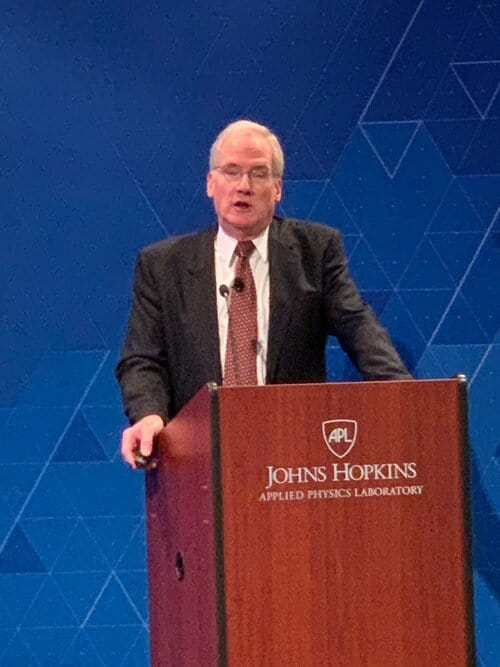 Mark Evans argues that the relentless advance of Artificial Intelligence, the emergence of 5th Generation communications, and an aging and crumbling infrastructure present a formidable triple threat to systems engineering practitioners. He believes that the survivability of the systems engineering profession requires a vision that will address this triple threat. He has had a 40-year career in systems engineering; holds an MS in electrical engineering and a Master’s in national strategy; and led architecture and systems engineering at the National Security Agency (NSA) in the United States of America.
Mark Evans argues that the relentless advance of Artificial Intelligence, the emergence of 5th Generation communications, and an aging and crumbling infrastructure present a formidable triple threat to systems engineering practitioners. He believes that the survivability of the systems engineering profession requires a vision that will address this triple threat. He has had a 40-year career in systems engineering; holds an MS in electrical engineering and a Master’s in national strategy; and led architecture and systems engineering at the National Security Agency (NSA) in the United States of America.
Listen to the presentation here
Download the speaker’s slides here
4.2 Systems-Related Specialist Partners Sought for Britain’s East-West Rail Project
East West Railway has published a prior information notice to find specialist partners to help the company deliver the proposed East-West Rail project to connect Oxford and Cambridge. The notice follows the British government’s approval of the preferred route option for the Bedford – Cambridge section, and the approval of a transport works order for the section linking Oxford and Aylesbury to Milton Keynes and Bedford, paving the way for construction to begin on this section.
The partners will collaborate with East-West Railway’s team as part of an integrated client under the Institute of Civil Engineer’s ‘Project 13’ principles, covering four areas:
- Management systems integration: creating and managing an IT ecosystem that facilitates the monitoring, reporting and forecasting of project performance.
- Project management and controls: providing project management resources for each of the project teams and program-wide project controls support.
- Commercial and procurement: supporting the procurement and commercial management of major contracts on the program, including the delivery partners and the wider supply chain.
- Engineering management: providing expertise in areas such as technical assurance, systems engineering, standards and requirements, project authorization and asset management.
“Our mission is to do things differently, to innovate and challenge the status quo in the rail and construction industries,” says East West Railway chief executive, Simon Blanchflower.
“Delivering a sustainable railway and bringing benefits to local communities at every stage of the project are critically important, which is why we’re keen to talk to companies of all sizes, including those that have a presence along the proposed East-West Rail line.”
4.3 Systems Analysis for a New Arctic
A scientific report by the International Institute for Applied Systems Analysis (IIASA) provides a new systemic view of the environmental, social, economic, and political picture of today’s Arctic. This new report is a holistic analysis of current policies, strategies, and declarations of Arctic and non-Arctic states with interests in the region, as well as documents of Indigenous peoples’ organizations.
The report was produced as part of the Arctic Futures Initiative (AFI) at IIASA, which was completed in summer 2019. The IIASA researchers analyzed 56 key policy documents to identify current trends in Arctic governance and geopolitics. It considers how different Arctic actors define and address issues around the following: the human dimension, governance, international cooperation, environmental protection, pollution, climate change, security, safety, economy, tourism, infrastructure, and science & education.
 4.4 How can expertise in research integration and implementation help tackle complex problems?
4.4 How can expertise in research integration and implementation help tackle complex problems?
Figure: Gabriele Bammer
Editor’s note: Dr. Brammer is developing the new discipline of Integration and Implementation Sciences (i2S) to improve research strengths for tackling complex real-world problems through synthesis of disciplinary and stakeholder knowledge, understanding and managing diverse unknowns, and providing integrated research support for policy and practice change.
The focus of this research, drawn from Bammer and colleagues (2020), is the expertise in research integration and implementation required to deal with five key dimensions of complexity:
- Delimiting the problem
- Managing contested problem definitions
- Managing critical, unresolvable unknowns
- Managing real-world constraints on ameliorating the problem
- Appreciating and accommodating the partial and temporary nature of solutions.
Find out more here.
4.5 The Field of Systems Engineering has a High Satisfaction Rate
According to a recent analysis by ClearanceJobs, the field of engineering is one of the older STEM fields that has shown a constant increase in the number of graduates each year since the 2008/2009 academic year. The field of systems engineering ranks highly as a career that pays well, has a constant growth rate between 3% and 9%, and has a high level of personal satisfaction.
4.6 KBR and International Council on Systems Engineering Sign Partnership Memorandum
KBR has signed a new memorandum of agreement (MOA) with the International Council on Systems Engineering (INCOSE). This agreement promotes a collaborative relationship in granting qualified KBR systems engineers a certification at the level of Associate Systems Engineering Professional (ASEP), Certified Systems Engineering Professional (CSEP), or Expert Systems Engineering Professional (ESEP).
The MOA provides a streamlined path for KBR employees to seek highly-valued systems engineering certifications. The signing ceremony took place on January 25th at the INCOSE International Workshop 2020 in Torrance, California. KBR’s new partnership with INCOSE and the memorandum’s signing signifies a positive step forward to enhance both organizations’ contributions to engineering.
Read more about the MOA here.
5. featured organizations
5.1 Infrastructure Report Card
Infrastructure Report Card is an organization committed to preserving the infrastructure of the USA through sustained investment, bold leadership, thoughtful planning, and careful preparation for the needs of the future.
Infrastructure is the foundation that connects the nation’s businesses, communities, and people, driving our economy, and improving our quality of life. For the U.S. economy to be the most competitive in the world, we need a first-class infrastructure system – transport systems that move people and goods efficiently and at reasonable cost by land, water, and air; transmission systems that deliver reliable, low-cost power from a sustainable range of energy sources; and water systems that protect the public health. Yet today, our infrastructure systems are failing to keep pace with the current and expanding needs, and investment in infrastructure is woefully inadequate. Elected leaders on both sides of the political aisle need to make good on promises they have made to improve our nation’s infrastructure and ensure these pledges don’t fall by the wayside after each election cycle.
5.2 International Electrotechnical Commission (IEC)
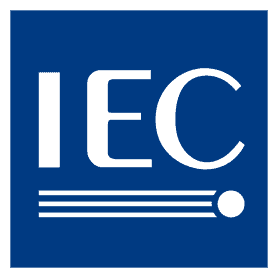
The International Electrotechnical Commission (IEC) is an international standards organization that prepares and publishes international standards for all electrical, electronic and related technologies – collectively known as “electrotechnology”. IEC standards cover a vast range of technologies from power generation, transmission and distribution to home appliances and office equipment, semiconductors, fiber optics, batteries, solar energy, nanotechnology and marine energy as well as many others. The IEC also manages four global conformity assessment systems that certify whether equipment, system or components conform to its international standards.
All electrotechnologies are covered by IEC Standards, including energy production and distribution, electronics, magnetics and electromagnetics, electroacoustics, multimedia, telecommunication and medical technology, as well as associated general disciplines such as terminology and symbols, electromagnetic compatibility, measurement and performance, dependability, design and development, safety and the environment.
International Electrotechnical Commission Website
5.3 International Institute for Applied Systems Analysis

Figure: Schloss Laxenburg, home of IIASA
The International Institute for Applied Systems Analysis (IIASA) is a scientific research institute located in Laxenburg, near Vienna, Austria. Founded in 1972, the International Institute for Applied Systems Analysis (IIASA) conducts policy-oriented research into problems of a global nature that are too large or too complex to be solved by a single country or academic discipline. IIASA is sponsored by its National Member Organizations in Africa, the Americas, Asia, and Europe. Its research is independent and completely unconstrained by political or national self-interest.
6. News on Software Toolz Supporting Systems Engineering
-
- “Product-centric Development is Dead: Long Live Product Line Engineering”
by
Alwyn Smit
Principal Consultant and Course Presenter, PPI
In this article published by DesignNews on 17 March 2020, the author talked with Dr. Charles Krueger, founder and CEO of BigLever Software, and William J Bolander, Principle Consultant at Methodpark.
I quite like the definition of PLE by William Bolander: “PLE is a set of processes, methods, and tools to develop a set of systems from a common set of engineering assets that maximizes reuse while managing their variations.”
What is interesting from this article is the amazing claim that PLE can bring up to a doubling or even tripling of efficiency. That is because it removes up to two thirds of the engineering effort in an organization that applies PLE. PLE enables an organization to have one set of common engineering artefacts such as requirements, designs, source code designs and associated documents to construct different configurations of a product that have different features.
Some of the additional benefits of PLE include an increase in quality, because fixing a defect once in any product means all the others get fixed for free.
There are a number of PLE tools available in the market, including “Gears” from BigLever (featured in SyEN 59) and “pure::variants” from Pure Systems.
Read the full article here.
6.2 WEBINAR: ‘4 Ways to Put Your Systems Engineering Model to Work’ by Vitech
April 30th
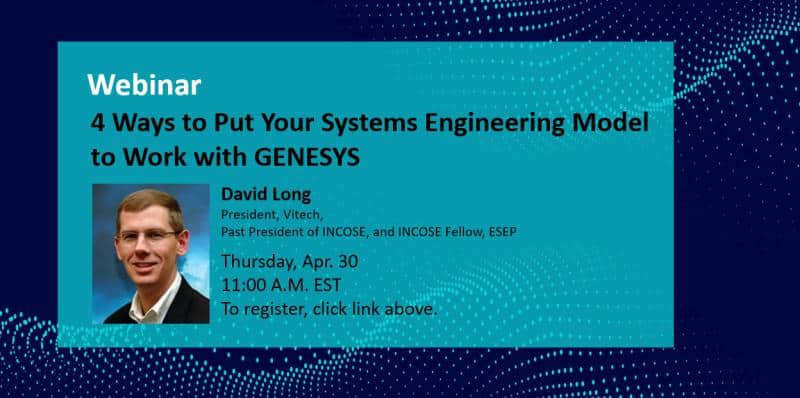
The date for Vitech’s webinar titled, ‘4 Ways to Put Your Systems Engineering Model to Work with Genesys’ has been changed to April 30th at 11am ET. The webinar is presenter to Vitech President, David Long. Register for the webinar here.
GENESYS is Vitech’s next generation software delivering connected systems engineering across the enterprise. GENESYS implements model-centric approaches leveraging modern technologies in a completely open architecture.
From the Vitech website:
GENESYS:
- Provides the SysML capability and DoDAF views your engineering team requires
- Empowers a model-based approach to accelerate your systems engineering efforts
- Increases project agility in the face of changing requirements and technologies
- Helps improve the financial business success of the project
- Contributes to reduced program costs
- Leads to increased product quality and performance
- Recovers schedule performance
- Improves program management quality and efficiency
- Improves learning and change
- Maintains project strategy alignment between departments
Read more about Genesys here.
7. Systems Engineering Publications
7.1 Disciplinary Convergence in Systems Engineering Research
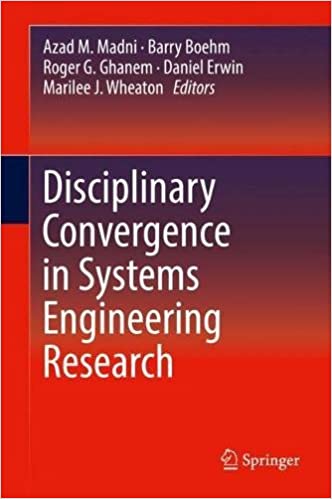
Azad M. Madni, Barry Boehm, Roger G. Ghanem, Daniel Erwin, and Marilee J. Wheaton
Editors
The theme of this volume on systems engineering research is disciplinary convergence: bringing together concepts, thinking, approaches, and technologies from diverse disciplines to solve complex problems. Papers presented at the Conference on Systems Engineering Research (CSER), March 23-25, 2017 at Redondo Beach, CA, are included in this volume. This collection provides researchers in academia, industry, and government forward-looking research from across the globe, written by renowned academic, industry and government researchers.
Formats: Kindle, hardcover, softcover
Publisher: Springer; Softcover reprint of the original 1st ed. 2018 edition (January 25, 2019)
ISBN-10: 3319872613
ISBN-13: 978-3319872612
7.2 Approach to Designing Systems for Delivering Value
by
Dr Anand Kumar, Edwin Anand Goruganthula, Doji Samson Lokku,
Dr Swaminathan Natarajan, and Prof. Kesav V Nori
INCOSE International Symposium – Volume 29, Issue S1
How value emerges from the interactions between different classes of stakeholders (like customers, service providers, suppliers, acquirers and so on) and the ways and means to enhance the interactions is a phenomenon that is increasingly becoming a significant game changer in any human endeavor. Increasingly, stakeholders expect something of interest to emanate for them whenever they participate in an endeavor. This thing that the stakeholders wish to create or experience is subjective and every stakeholder has their own perception of what this thing is. It is often the case that the thing that enthuses a stakeholder is the perceived value that they feel they can obtain; and the thing that they experience or create when participating in the endeavor is the actual value. In this situation, stakeholders often try to minimize the gap between their perceptions and actuals. This is often difficult to achieve as the notion of what is of value is time and stakeholder dependent. In order to address these issues, in this paper, a systematic approach to facilitate stakeholder value creation is presented and the underlying rationale for the approach discussed. This approach is based on the premise that in all human endeavors, goal or purpose of the endeavor, human centric processes, quality of these human‐centric processes, outcomes and the quality of the outcomes determine the value that different stakeholders create or experience. It is essential to understand, establish and articulate the right value influencing factors and criteria so that value is created for all stakeholders. This is further substantiated by the system value cycle wherein value created by the stakeholder by utilizing one or more systems. A set of eight different processes to institutionalize the stakeholder value creation dynamics is also presented to aid in the value co‐creation, sustenance and transformation.
Access the Paper at the Wiley Online Library
7.3 The PPI-INCOSE Systems Engineering Tools Database – What’s Coming
by
René King, PPI
INCOSE International Symposium – Volume 29, Issue S1
The Systems Engineering Tools Database (SETDB) project is a collaboration between INCOSE and Project Performance International (PPI) to reinstate and revive the popular on‐line catalogue of tools information that was lost in a migration activity several years ago. “Walking the talk”, the project team has of course taken a systems engineering (SE) approach comprising thorough, and separate, problem definition and solution description artifacts. Thus far, a rigorous system requirements analysis activity has produced a detailed set of SETDB use cases, a description of intended use (OCD/CONUSE) and a baselined specification of requirements – all developed in close collaboration with INCOSE and PPI stakeholders. The products of that activity are presented in detail in this paper.
One of the points of emphasis during development is to distinguish between the SETDB enterprise system – which comprises all that is entailed in providing the database service to its users, including computing devices, the INCOSE website, the internet, operational processes and project infrastructure – from the SETDB Information System. The SETDB Information System (SETDBIS) is the main technical solution element of the project and will exist as a subsystem of the larger SETDB system. Making this distinction ensures that all of the elements necessary to meet the SETDB stakeholder needs are identified and included in the development.
The next step of the project is to use the outputs from the requirements analysis process as directives to develop the SETDB solution to deliver its initial operational capability (IOC) within the allotted project timelines. An incremental development process for the information system has been decided upon, to enable iterative improvement based on feedback from testing and demonstration to users. Mapping and alignment of the INCOSE SE Handbook Processes and PPI SE process elements to tool functionality in order to define the tool categories is a critical and challenging task. The effort to map and harmonize (where possible) systems engineering methods supported by tool functionality will result in intuitive delivery of detailed tool information to SETDB users.
Access the Paper at the Wiley Online Library
7.4 Systems Engineering Pathology: Comprehensive Characterization of Systems Engineering Dysfunction
by
Heidi L. Davidz, Scott Jackson, and Dale Thomas
INCOSE International Symposium – Volume 28, Issue 1
In order to characterize dysfunction in the execution of the Systems Engineering (SE) process in a more methodical and systematic way, the Systems Science concept of Systems Pathology is extended to Systems Engineering Pathology. Poor SE execution can be due to inadequate execution, insufficient budgets, deficient interfacing, and other factors. These can be addressed by program/project audits and lessons learned. However, applying the science of Systems Pathology can provide a more integrated and methodical approach to address poor SE execution. SE Pathology can provide the holistic approach needed to better characterize dysfunction, for a better chance at intervention, prevention, and ultimately program success. Through a literature review, the logic behind Systems Engineering Pathology is explained and existing Systems Engineering Pathology work is discussed. These sources are aggregated to provide an expanded list of typical SE dysfunctions. Next steps for empirical study are proposed. Transfer of SE Pathology research findings to SE practice is discussed. As medicine has been gradually accumulating an understanding of causes, detection and treatment of diseased states, perhaps SE can begin to accumulate an understanding of causes, detection and treatment of dysfunctional execution. The objective would be to better achieve affordable, healthy SE functions enabled to positively influence program outcomes.
Access the Paper at the Wiley Online Library
7.5 Dilemmas in a General Theory of Planning
The search for scientific bases for confronting problems of social policy is bound to fail, because of the nature of these problems. They are “wicked” problems, whereas science has developed to deal with “tame” problems. Policy problems cannot be definitively described. Moreover, in a pluralistic society, there is nothing like the undisputable public good, there is no objective definition of equity, policies that respond to social problems cannot be meaningfully correct or false, and it makes no sense to talk about “optimal solutions” to social problems unless severe qualifications are imposed first. Even worse, there are no “solutions” in the sense of definitive and objective answers.
Download the Paper (PDF)
7.6 Engineer Your Career: A Complete Guide to Landing a Job in Engineering
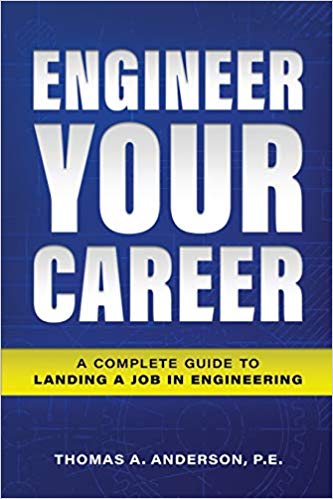
by
From the Amazon Website:
When it comes to landing your dream engineering job, one needs a plan in order to avoid common pitfalls, promote one’s skills, and sell oneself as the needed candidate. The 13 chapters of this engineering job interview book will help you prepare for job interviews in the engineering field, identify your professional goals and plan your career, and learn how to network and sell yourself.
Formats: Kindle, paperback
Publisher: Self-published (April 5, 2019)
ISBN-10: 0578475448
ISBN-13: 978-0578475448
8.1 New Online Master’s Degree for Creative Problem Solvers
Master of Science in Integrated Design, Business, and Technology
University of Southern California (USC) USA
USC’s online Master of Science in Integrated Design, Business and Technology is an integrative cross-disciplinary program that teaches the principles of design as the basis for creative problem-solving. The program’s innovative curriculum brings together faculty from USC’s schools of business, engineering, communication, art and design, and will help you develop the business and technology skills needed to lead multi-disciplinary teams across all levels of business.
8.2 Indian Railways has launched a Joint Master’s Program with the University of Birmingham
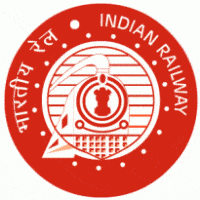
Vinod Kumar Yadav, Chairman, Railway Board and Lord Karan Billimoria, Chancellor, University of Birmingham (Edgbaston, Birmingham, United Kingdom) have announced a joint Master’s program in Railway Systems Engineering and Integration in academic year 2020-2021.
Mr. Yadav said that a lot of transformation work has been done in India Railways most of which has focused on capacity enhancement and modernization of Railways and now the Indian Railways looks forward to a long-term association with the University of Birmingham. Sir David Eastwood, Vice-chancellor said that the University is delighted to work with the Indian Railways.
The program is a dual M.Sc. under which students will obtain post-graduate degrees from both institutions as they spend a year at each institution. The initiative will greatly benefit the students of the National Rail Transportation Institute (NRTI) since it will provide them access to the world-class expertise and facilities in railway systems at the Birmingham Center for Railway Research and Education (BCRRE).
8.3 Top Ten Robotics Engineering Universities and Courses in 2020
Today, robots as the automated machines, have become a huge part of our lives in an effort to help people in an assortment of settings, from assembling processes to working in complex conditions, unsatisfactory for human life. Moreover, robotics as a field has penetrated a number of industries to accomplish assorted tasks by structuring mechanical devices. The upsurge in technological advancements and demand for robotics professionals in the market has mandated the applicable education of budding tech-enthusiasts.
Here is the list of the top ten robotics engineering courses and universities that are redefining the face of robotics education.
8.4 Applications open for a Human-Machine Interactions Assistant Professor at Carleton University in Ottawa, Ontario’
The University is interested in both theoretical and applied research and in teaching expertise in the general field of Human-Machine Interactions, including novel HMI opportunities, design for usability, and cognitive aspects (e.g., gender sensitive). The candidate is expected to have a desire to promote interest in young people, particularly those in underrepresented groups, in an engineering career. This is a tenure-track appointment beginning July 1, 2020.
9. Some Systems Engineering-Relevant Websites
Performance-Based Earned Value

This new Performance-Based Earned Value website provides the rationale for implementing an earned value (EV) system that integrates technical performance and quality with cost and schedule. Links are provided for a tutorial by EV industry expert Paul Solomon; articles explaining why an integrated approach is required to obtain value from using EV; information concerning the USA Defense Federal Acquisition Regulation Supplement (DFARS); evaluations of Earned Value Management System (EVMS) implementation; lessons learned and recommendations for project and program managers; and many other related topics and resources.
EVMS Process Overview
This article provides an introduction to the basic concepts of earned value management (EVM), from initial project planning through execution including data analysis techniques and baseline revisions. The intent is to inspire an appreciation for the earned value concept and emphasize how performance measurement techniques can be a valuable management tool.
https://www.humphreys-assoc.com/evms/basic-concepts-earned-value-management-evm-ta-a-74.html
USA Infrastructure Report Card
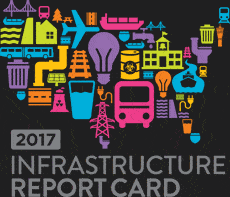
The USA Infrastructure Report Card indicates that some incremental progress has been made toward restoring the country’s infrastructure. The areas of infrastructure that improved benefited from vocal leadership, thoughtful policymaking, and investments that garnered results. These improvements demonstrate what can be accomplished when solutions that move projects forward are approved and implemented.
https://www.infrastructurereportcard.org/solutions/
Open Artificial Intelligence Research

OpenAI is a research laboratory based in San Francisco, California. Its mission is to ensure that artificial intelligence (AI) benefits all of humanity. The OpenAI Charter describes the principles that guide the execution of this mission.
10. Standards and Guides
10.1 International Electrotechnical Commission Standards
IEC standards have numbers in the range 60000–79999 and their titles take a form such as IEC 60417: Graphical symbols for use on equipment. Following the Dresden Agreement with CENELEC the numbers of older IEC standards were converted in 1997 by adding 60000, for example IEC 27 became IEC 60027. Standards of the 60000 series are also found preceded by EN to indicate that the IEC standard is also adopted by CENELEC as a European standard; for example IEC 60034 is also available as EN 60034.
The IEC cooperates closely with the International Organization for Standardization (ISO) and the International Telecommunication Union (ITU). In addition, it works with several major standards development organizations, including the IEEE with which it signed a cooperation agreement in 2002, which was amended in 2008 to include joint development work.
Standards developed jointly with ISO such as ISO/IEC 26300 (Open Document Format for Office Applications (OpenDocument) v1.0), ISO/IEC 27001 (Information technology, Security techniques, Information security management systems, Requirements), and CASCO ISO/IEC 17000 series, carry the acronym of both organizations. The use of the ISO/IEC prefix covers publications from ISO/IEC Joint Technical Committee 1 – Information Technology, as well as conformity assessment standards developed by ISO CASCO and IEC CAB (Conformity Assessment Board). Other standards developed in cooperation between IEC and ISO are assigned numbers in the 80000 series, such as IEC 82045–1.
IEC standards are also being adopted by other certifying bodies such as BSI (United Kingdom), CSA (Canada), UL & ANSI/INCITS (United States), SABS (South Africa), SAI (Australia), SPC/GB (China) and DIN (Germany). IEC standards adopted by other certifying bodies may have some noted differences from the original IEC standard.
10.2 PikeOS 5.0 RTOS Targets Safety and Security-critical Systems
Sysgo has released version 5.0 of its real-time operating system PikeOS for safety and security-critical systems, expanding certification against all current safety and security standards. The RTOS comes with improved tools to accelerate development and improve user friendliness, and optimized support for multi-core systems. In addition, the number of partitions supported by the integrated hypervisor or separation kernel has been significantly increased. Partitions are used by PikeOS to strictly separate multiple guest operating systems and applications, often of different criticality, while still allowing communication through explicitly configured channels.
With these innovations, PikeOS 5.0 represents a platform on which systems for the highest certification levels such as DAL-A in avionics, SIL-4 for railway applications or ASIL-D in the automotive industry can be implemented. The POSIX Guest-OS has also been revised, preparing PikeOS 5.0 for use in AUTOSAR adaptive projects. The certification of systems and applications will be simplified and accelerated by the new qualified configuration tools. They are integrated into the Eclipse-based development environment CODEO and eliminate the need for time-consuming validation of generated binaries. In addition, any subset of the configuration can be exported as a reusable component, simplifying team development.
10.3 Industry Standard Guidelines for EVMS (2019)
Earned Value Management (EVM) is a widely accepted industry best practice for program management, used across the Department of Defense (DoD), the Federal Government, and the commercial sector. Government and industry program managers use EVM as a program management tool to provide joint situational awareness of program status and to assess the cost, schedule, and technical performance of programs for proactive course correction. An EVM System (EVMS) is the management control system that integrates a program’s work scope, schedule, and cost parameters for optimum program planning and control.
The DoD EVMS Interpretation Guide (EVMSIG), provides the overarching DoD interpretation of the 32 Guidelines where an EVMS requirement is applied. It serves as the authoritative source for EVMS interpretive guidance and is used as the basis for the DoD to assess EVMS compliance with the 32 Guidelines. The Guide provides the DoD Strategic Intent behind each guideline for a compliant EVMS. As applicable, the DoD Strategic Intent section may clarify where differences in guideline interpretation exist for development and production type work. DoD agencies and organizations charged with conducting initial and continuing EVMS compliance activities will establish amplifying agency procedures and guidance to clarify how they are implementing this Guide to include the development of evaluation methods for ensuring compliance with the 32 Guidelines. Note: the EVMSIG is not a replacement for a contractor to develop and maintain formalized EVM system description documentation and processes.
Access the Guide here.
11. Some definitions to close on
11.1 Vision
1. The ability to think about or plan the future with imagination or wisdom.
Source: Oxford
2. An end that describes the future state of the enterprise, without regard to how it is to be achieved; a mental image of what the future will or could be like.
Source: DODAF DoD Architecture Framework V2.02 Acronyms List and Glossary of Terms
11.2 Capability
1. The power or ability to do something.
Source: Oxford
2. A measure of the systems’ ability to achieve mission objectives, given the system condition during the mission.
Source: Defense Systems Management College
11.3 Technical Standard
Technical standards document specific technical methodologies and practices to design and implement.
Source: DODAF DoD Architecture Framework V2.02 Acronyms List and Glossary of Terms
11.4 Due Diligence
Due diligence is the investigation or exercise of care that a reasonable business or person is expected to take before entering into an agreement or contract with another party, or an act with a certain standard of care.
Source: Wikipedia
For more information on systems engineering related conferences and meetings, please go to our website.
The featured event for this edition is:
Global Digital Development Forum
Starts May 6th
This virtual ICT4D conference will be a global transformative peer-learning digital development event specifically designed to include practitioners from low- and middle-income countries. The Global Digital Development Forum aims to move past the significant travel and cost barriers that restrict attendance at traditional events and lead the industry with:
- A headlining keynote presentation from USAID and multiple interactive online sessions, led by trained facilitators.
- Sessions spanning the globe from 6:00 GMT to 22:00 GMT featuring your peers at the cutting edge of technology and development in Asia, Africa, Europe, and Americas.
- Free participation in engaging compelling, relevant sessions on TechChange’s robust online learning platform.
- Inspiring experiences and results from innovative projects that achieve development goals with new and emerging technologies.
Topics:
- Digital Health: COVID-19, HIV/AIDS, Mother & Child, Family Planning, Health Workforce, Supply Chain
- EduTech: Primary, Secondary, Tertiary, Adult, Informal, and Digital Literacy and Skills
- AgriTech: Smallholder Farming, Animal Husbandry, Aquaculture, and their Value Chains
- Digital Economy: Digital Financial Services, Digital Identity, Agency and Inclusion
- eGovernment: Community Engagement, Elections, Activism, Human Rights
- Humanitarian Response: Natural disasters, Conflict/post-conflict
- Responsible Data: Collection, Analysis, Presentation, Risks, and Protections
This forum will be a highly participatory, community-driven event and the forum’s organizers are actively seeking practitioners from around the world with a wide range of ideas, experience, and backgrounds to lead each type of session.
Find out more information here
13. PPI and cti News
13.1 PPI Goes Live-Online with PPI Live-Online™
March has been a big month, with the launch of PPI’s new, live-online training service PPI Live-Online™ to our clients. Not only a launch, but successful public and in-house deliveries of four online courses to clients on four continents, with a largest group size of 27! And under its own new PPI Live-Online™ branding (see below).
All PPI training that was previously available only by physical delivery is now also available live online. Availability online includes many courses that were offered only on-site for physical delivery. See https://www.ppi-int.com/on-site-training/
PPI Managing Director Robert Halligan said this week “We believe that the world has changed forever. PPI continues its leadership in delivering value to its clients via systems engineering training worldwide with the introduction of PPI Live-Online™. PPI Live-Online and its benefits to clients of PPI in terms of outstanding content, expert facilitators, flexibility, cost and avoidance of travel are here to stay.”

Systems Engineering

This world-renowned course, already delivered to over 11,000 professionals in 40 countries, provides a proven-effective set of technical and management principles and practices that integrate to reduce time and cost, delight stakeholders, and reduce risk in technical projects. Systems engineering delivers benefit regardless of domain, project size and technologies.
Upcoming courses:
27 Apr – 01 May, 2020 | Oceania UTC +10:00 (AEST 8:30)
04 – 08 May, 2020 | South Africa UTC +2:00 (SAST 8:00)
11 – 15 May, 2020 | Turkey UTC +3:00 (TRT 8:00)
18 – 22 May, 2020 | Europe UTC +2:00 (CEST 9:00)
18 – 22 May, 2020 | United Kingdom UTC +1:00 (BST 8:00)
01 – 05 Jun, 2020 | Oceania UTC +10:00 (AEST 9:00)
15 – 19 Jun, 2020 | North America UTC -4:00 (EDT 8:00)
22 – 26 Jun, 2020 | United Kingdom UTC +1:00 (BST 8:00)
22 – 26 Jun, 2020 | Europe UTC +2:00 (CEST 9:00)
06 – 10 Jul, 2020 | South Africa UTC +2:00 (SAST 8:00)
17 – 21 Aug, 2020 | South America UTC -3:00 (BRT 9:00)
31 Aug – 04 Sep, 2020 | Asia UTC +8:00 (SGT 9:00)
31 Aug – 04 Sep, 2020 | North America UTC -4:00 (EDT 8:00)
14 – 18 Sep, 2020 | Europe UTC +2:00 (CEST 9:00)
14 – 18 Sep, 2020 | United Kingdom UTC +1:00 (BST 8:00)
28 Sep – 02 Oct, 2020 | Oceania UTC +10:00 (AEST 9:00)
Requirements Analysis & Specification Writing

Requirements Analysis and Specification Writing are sciences practiced by many, mastered by surprisingly few. Yet the payoff from achieving excellence in these areas is large indeed. Upon completion of training, participants will have an understanding of how to effectively capture and validate requirements, write good requirements and appropriately structure requirements specifications for maximum usability.
Upcoming courses:
18 – 22 May, 2020 | Europe UTC +2:00 (CEST 9:00)
18 – 22 May, 2020 | United Kingdom UTC +1:00 (BST 8:00)
18 – 22 May, 2020 | South Africa UTC +2:00 (SAST 8:00)
29 Jun – 03 Jul, 2020 | Turkey UTC +3:00 (TRT 8:00)
03 – 07 Aug, 2020 | Oceania UTC +10:00 (AEST 9:00)
03 – 07 Aug, 2020 | South Africa UTC +2:00 (SAST 8:30)
17 – 21 Aug, 2020 | Oceania UTC +10:00 (AEST 8:30)
24 – 28 Aug, 2020 | Asia UTC +8:00 (SGT 8:30)
Systems Engineering Management
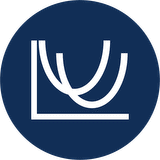
This course provides in-depth coverage of how to manage engineering projects to maximize project success, within the project’s given constraints. The course establishes principles and provides methods for successfully managing risk inherent in the technical program, and for getting the best out of people, individually and in teams.
Upcoming courses:
18 – 22 May 2020 | Asia UTC +8:00 (SGT 9:00)
15 – 19 Jun 2020 | United Kingdom UTC +1:00 (BST 8:00)
15 – 19 Jun 2020 | Europe UTC +2:00 (CEST 9:00)
15 – 19 Jun 2020 | Oceania UTC +10:00 (AEST 9:00)
07 – 11 Sep 2020 | United Kingdom UTC +1:00 (BST 8:00)
07 – 11 Sep 2020 | Europe UTC +2:00 (CEST 9:00)
14 – 18 Sep 2020 | South Africa UTC +2:00 (SAST 8:00)
Requirements, OCD & CONOPS in Military Capability Development
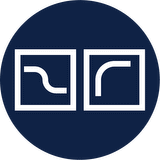
This course is a 5-day immersion in the development of military capability, with a focus on problem definition, and concept of operations (how the military outcome is to be achieved). The course, easily migrated to other application domains, confronts the reasons for many large project failures. Delegates receive a library of example work products for a submarine SAR problem and solution.
Upcoming courses:
04 – 08 May 2020 | Oceania UTC +10:00 (AEST 9:00)
25 – 29 May 2020 | Europe UTC +2:00 (CEST 9:00)
25 – 29 May 2020 | South Africa UTC +2:00 (SAST 8:00)
25 – 29 May 2020 | United Kingdom UTC +1:00 (BST 8:00)
06 – 10 Jul 2020 | South America UTC -03:00 (BRT 9:00)
21 – 25 Sep 2020 | North America UTC -7:00 (EDT 8:00)
Architectural Design
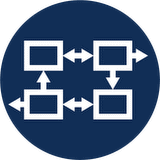
This course addresses the principles and methods of designing, regardless of what is being designed. The training is strong in Model-Based Systems Engineering (MBSE) methods supported by substantial workshop activity and provides insight into the realities of current modelling languages and tools, and the directions in which model-based design is evolving. Delegates learn how to perform techniques of development of physical solution, supporting development of logical solution, evaluation of solution alternatives (trade-off studies) and design iteration. We also provide introductory coverage of the disciplines of reliability engineering, safety engineering, maintainability engineering and producibility engineering.
Upcoming courses:
13 – 17 Jul 2020 | South America UTC -3:00 (BRT 9:00)
17 – 21 Aug 2020 | South Africa UTC +2:00 (SAST 8:00)
07 – 11 Sep 2020 | Europe UTC +2:00 (CEST 9:00)
07 – 11 Sep 2020 | United Kingdom UTC +1:00 (BST 8:00)
13.2 CTI’s First Ever CL-O Course
CTI’s INCOSE SEP Prep Exam Course – everything you need to know to pass the INCOSE Knowledge Exam!
25-28 May 2020
Our first-ever CTI Live-Online will take place 25 May to 28 May 2020! With CTI Live-Online delivery, you will gain access to our premium INCOSE Knowledge exam preparation course from the comfort of your own home or office. This is achieved by maintaining a combination of high-quality course materials, expert instruction and significant interaction among all participants to make the learning process effective and enjoyable!
Over the course of 4 days, led by an experienced and qualified facilitator, you will be taken on an immersive journey into the INCOSE Systems Engineering Handbook V4 (SEH). CL-O brings the SEH to life in such a way that you are well placed to pass the exam on your first attempt* and so that you may apply concepts of the Handbook to your engineering work.
Your success is our priority!
*If you don’t pass the exam on your first attempt, you are welcome to join in on another CL-
O course of your choice at no charge.
Structure of the class (times shown at UTC+1)
Monday to Thursday
Session 1: 08:30 – 10:30
Session 2: 11:30 – 13:30
Session 3: 14:30 – 16:30
Friday
BONUS SESSION: 08:30 – 10:30
For more information please contact CTI
13.3 PPI/CTI and Covid-19
The world has changed a lot since publication of the last edition of SyEN. More than anything else, we wish SyEN readers health and safety in this era of Covid-19.
For our part, all PPI family members are now working from home. We are still going strong, doing our bit to try and keep the world moving. We have introduced PPI Live-Online and CTI Live-Online, for live-online delivery of all PPI and CTI training courses to home and office, we continue to help clients harness the power of systems engineering with our consulting services, and an outstanding (we believe) engineering management Webinar series is in the works.
Some public courses are still scheduled for physical delivery from July onwards in small regional areas. Such deliveries will only take place in accordance with strict government guidelines and when restrictions are safely lifted. We will not compromise the health and safety of our training participants. Limited on-site physical deliveries may also be possible in some locations under similarly stringent conditions.
13.4 Ten Years at PPI!
We would like to congratulate PPI & CTI Course Presenter, Clive Tudge on his 10-year anniversary working with PPI. Since March 2010, Clive has presented 108 courses both for PPI and CTI to some 1,340 delegates over a total of 440 days. Clive, you have made your presence an invaluable one in our company! Wishing you many more years of distinguished excellence! Looking forward to the next 10 years!
14. PPI and CTI Events
For a full public PPI Live-Online training course schedule, please visit https://www.ppi-int.com/ppi-live-online/
For a full public PPI training course schedule, please visit https://www.ppi-int.com/course-schedule/
For a full public CTI Live-Online INCOSE SEP Exam Preparation course schedule, please visit https://certificationtraining-int.com/incose-sep-exam-prep-course/
To enquire about CTI Live-Online INCOSE SEP Exam Preparation Training for your organization, please visit https://certificationtraining-int.com/on-site-training/
15. Upcoming PPI Participation in Professional Conferences
PPI will be participating physically in the following upcoming events. We support the events that we are sponsoring, and look forward to meeting old friends and making new friends at the events at which we will be exhibiting.
The INCOSE International Workshop 2021
Date: 29 – 31 January, 2021
Location: Seville, Spain
Kind regards from the PPI SyEN team:
Robert Halligan, Editor-in-Chief, email: rhalligan@ppi-int.com
Ralph Young, Editor, email: ryoung@ppi-int.com
René King, Managing Editor, email: rking@ppi-int.com
Project Performance International
2 Parkgate Drive, Ringwood, Vic 3134 Australia
Tel: +61 3 9876 7345
Fax: +61 3 9876 2664
Tel Brasil: +55 12 9 9780 3490
Tel UK: +44 20 3608 6754
Tel USA: +1 888 772 5174
Tel China: +86 188 5117 2867
Web: www.ppi-int.com
Email: contact@ppi-int.com
Copyright 2012-2020 Project Performance (Australia) Pty Ltd, trading as
Project Performance International
Tell us what you think of PPI SyEN. Email us at syen@ppi-int.info.


